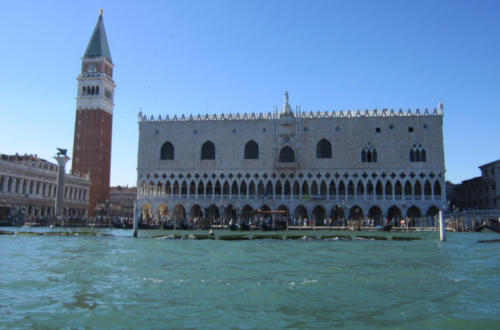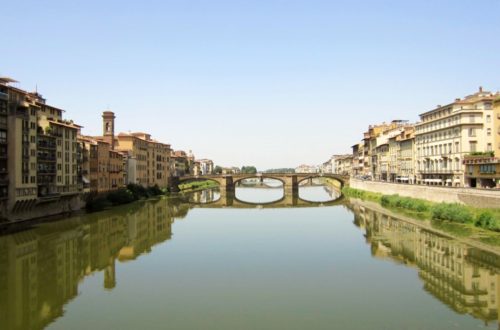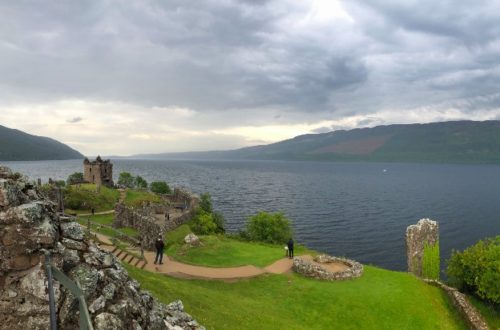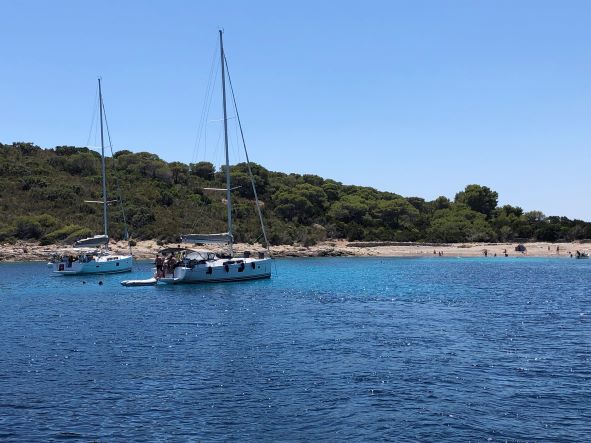
10 Sites to See When You Sail Croatia
Have you ever taken advantage of an opportunity that was not even on your radar? In 2020, I came across the opportunity to book an island hopping trip to sail Croatia for summer 2021. Croatia was never a country that had been at the top of my bucket list, but this trip was too good to pass up. I mean, who could pass up beautiful turquoise water, crystal clear beaches, and a little bit of history, right? Especially when the price tag was so incredibly reasonable. I said sign me up! And it was AMAZING!
The trip ALMOST didn’t happen thanks to crazy Covid, but a few months before our trip borders were open, and we were able to get in and out with ease. Having our negative Covid tests in hand, we set out to sail the Adriatic Sea, our itinerary literally in the wind!
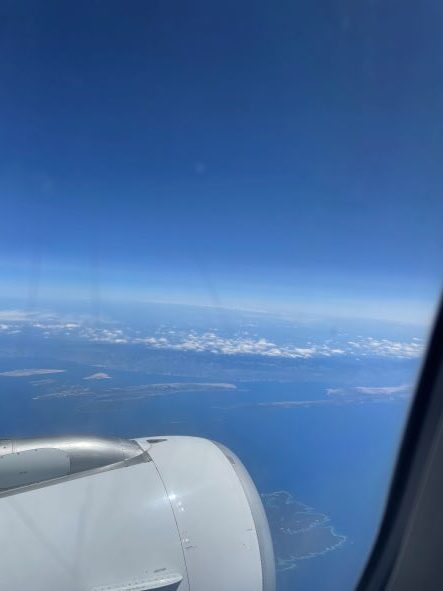
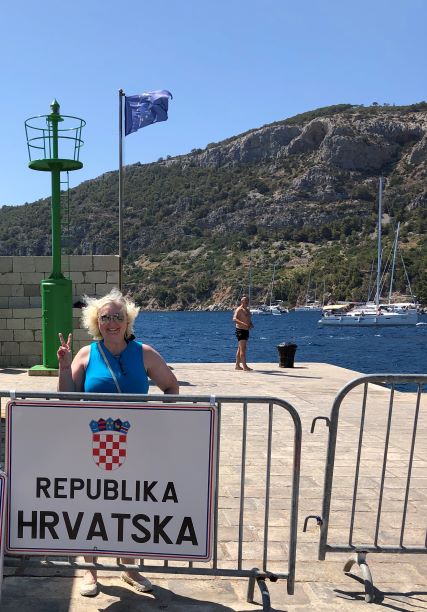
Brief History of Croatia
A VERY brief history as this post turned out way longer than I expected! Croatia was first inhabited by Neanderthals over 30,000 years ago! By the 4th century BC, the Greeks had colonized some of the islands, but the Romans had taken over by the 1st century BC.
Croats from north of the Black Sea first arrived in the 6th century, however, in the early 12th century they were taken over by the Austrians. They were controlled by the Venetians in the 14th century, and the Ottoman Empire in the 16th century. It went back to Austria in the 17th century until it was conquered by Napoleon.
Shortly after, half of Croatia went back to Austria, and the other half went to the Habsburg Empire. When Austria-Hungary was dismantled after World War I, Slovenes, Croats, and Serbs formed Yugoslavia. World War II saw invasion by Germany, and the execution of many ethnic groups. The country became a communist nation after the War in 1945.
The first free elections were held in 1990, and Croatia voted to leave Yugoslavia. This resulted in a war with the Yugoslav People’s Army and pitted Serbs against Croats, which triggered ethnic cleansing of the Croat people in Serb occupied areas. The war ended in 1995, and Croatia is now a parliamentary democracy. Croatia has been a member of the European Union since 2013, however, they continued to use their own currency, the Kuna, until 2023 when they switched to the Euro.
Getting There
Getting there was somewhat interesting (as always). Our layovers were a little crazy, for example, I would NOT recommend only having 40 minutes to change planes AND terminals AND clear security in Zurich to anyone! But we made it.
We were sailing out of Trogir, so the closest airport was Split, which is a very small airport. There were some definite advantages to this, however. First, clearing customs took all of about 20 minutes, and a bank for currency exchange was on site. Additionally, when we flew home, there was a walk-in Covid testing center on site at the airport, and we were able to get our results back in about 15 minutes!
But enough about all of that! We arranged for a ride from the airport to the marina using this car service, which was also reasonably priced. Once we arrived at the marina, we easily found our sailing yacht, Flying Colours.
We met our Skipper for the week, Paul Finnigan. He was fantastic, and has been sailing since he was a kid! We were in great hands all week, and he was extremely helpful and patient with my million pre-trip questions. He even drove by the Split airport and took a video for me so I would know exactly where we had to go to get our Covid tests to return home! I will leave his contact information at the end if you are interested in a similar adventure. He sails every summer.
We all got settled into our cabins, and received a short orientation about the boat. Our cabin had some of the electrical switches (like breakers I suppose?) along the front of the sleeping area. We were cautioned to try not to touch them. I am sure you can guess how that went. Haha. At one point the first day, the power wouldn’t come on – one of us had tripped the circuit. Uh sorry!
Sailing the Adriatic Sea
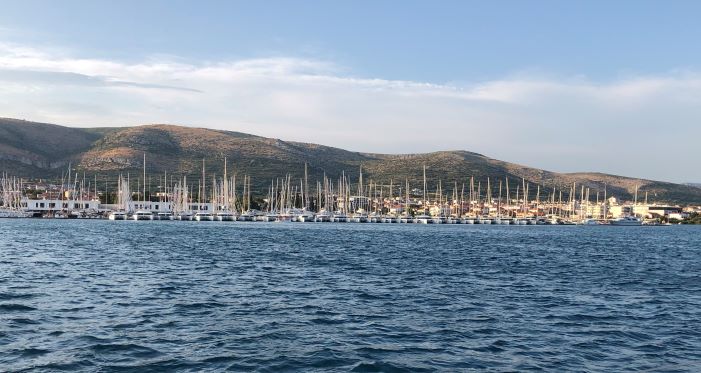
We sailed out of the Marina Baotić just outside of Trogir on a Saturday afternoon. As I said before, our itinerary was left to the wind, but ended up being 10 stops as follows:
Day 4 – Lovište, Peljesac Peninsula
Day 5 – Korčula Town & Vela Luka, Korčula
Day 6 – Marin Kovač, Pakleni Islands & Stari Grad, Hvar
One of the coolest things to me about this trip was that we were all “crew” on the boat. This meant that we all got to learn a little bit about sailing, and help sail the boat under Skipper Paul’s direction, which included manning the sails as well as steering the boat. So be aware that this is a sailing yacht, not a luxury yacht. No one gets to be a diva sunbathing on the deck for the ENTIRE week. Haha!
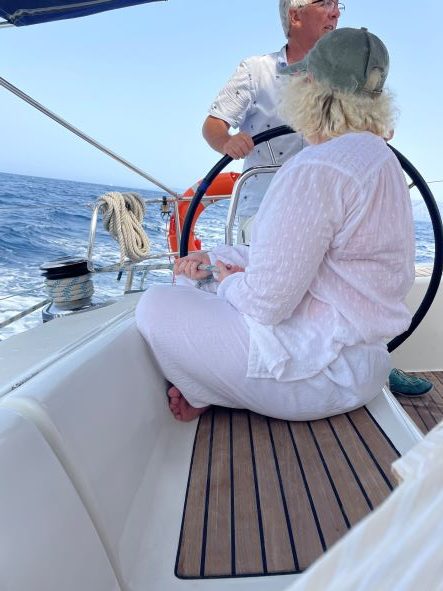
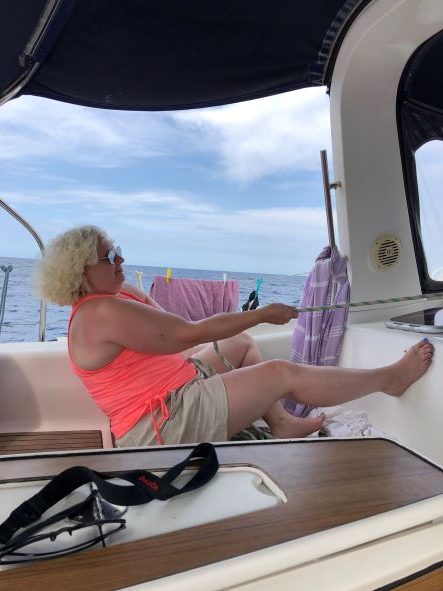
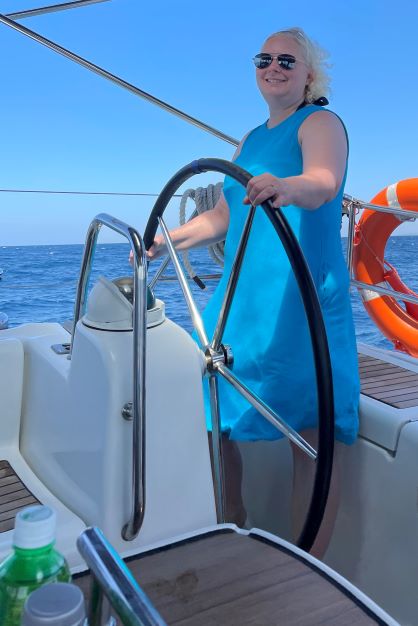
We learned so much! We learned the proper way to coil the lines (rope), what a jammer is, and what it is used for. We learned the difference between a tack and a jibe when changing directions. Tacking is moving the bow (front) of the boat through the wind, and jibing is moving the stern (back) of the boat through the wind. We learned the difference between the mainsail and the jib, and how to tie a few knots!
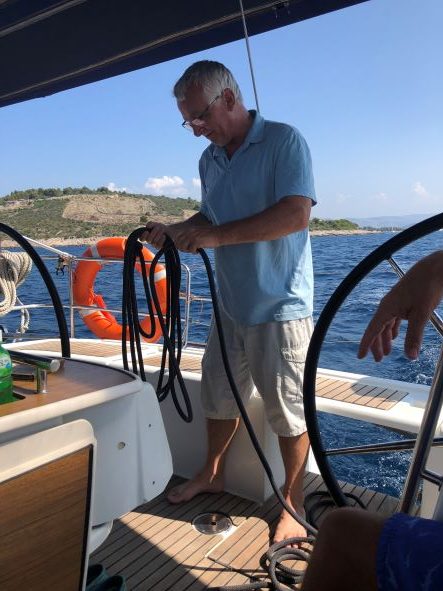
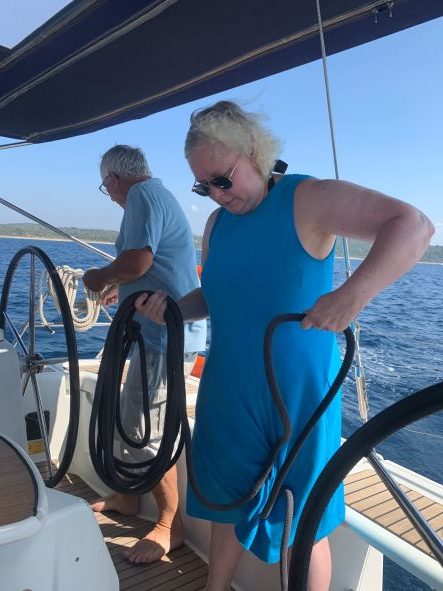
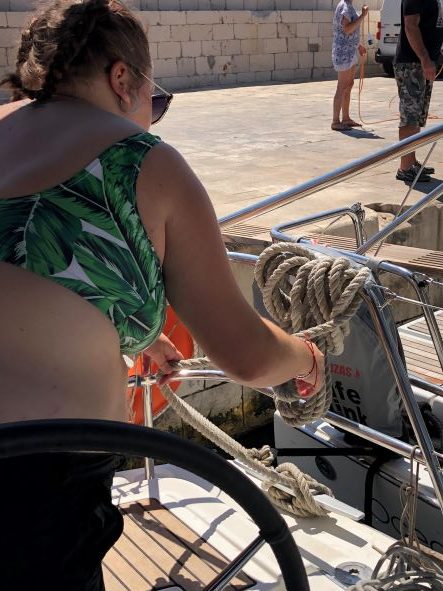
It wasn’t ALL work and no play. We did have some time to relax and enjoy the breeze and the views!
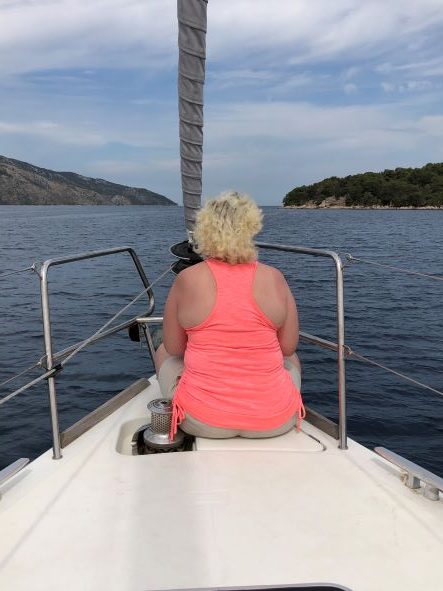
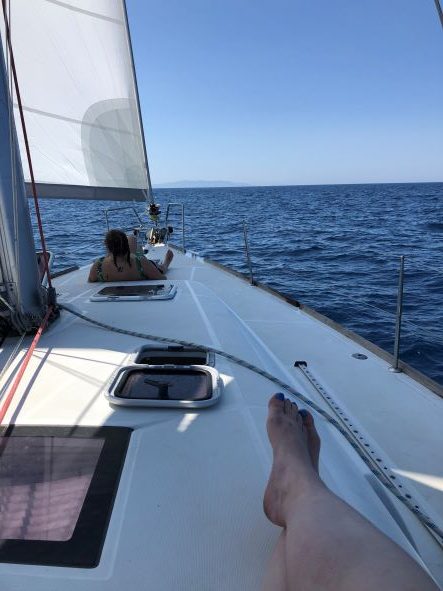
Blue Lagoon
Our first stop on our cruise was a place called The Blue Lagoon where we stopped for a short swim and snorkel. The water here was absolutely gorgeous! We spent our first night on board anchored at a buoy near the Blue Lagoon.
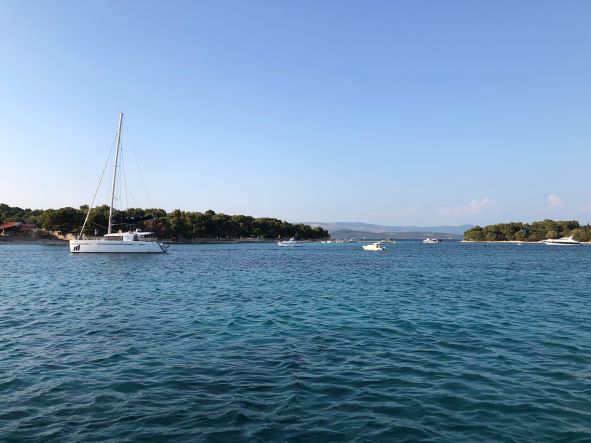
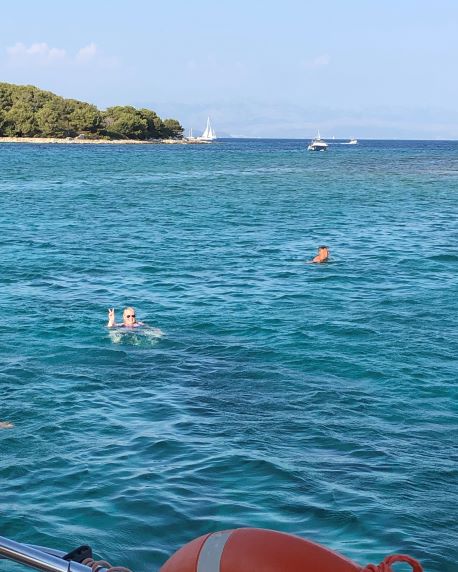
Side story: so on our way to the Blue Lagoon, one of our “crew” began getting sea sick and threw up over the side of the boat. Now, the Adriatic Sea is very calm, but it is still possible to get sea sick. My Dad was in the Navy, and he warned me before we left that it wouldn’t be like on a cruise ship where they have stabilizers, and suggested I take some Dramamine. Well, I insisted that I would NOT get seasick, but I took some Dramamine with us just in case. I did have to tell him he was right when we got back home.
As it turns out, if enough people talk about seasickness for long enough, it gets in your head. You start to think, “I hope I don’t get seasick.” And then you begin to question yourself. “Do I feel sick? Uh oh, am I feeling nauseous?” And then after you dwell on it long enough, you find yourself very discreetly heading below deck to barf in the bathroom and hope no one hears you. Lesson learned, don’t be stubborn, and take the Dramamine! Haha!
Komiža, Vis
We set sail again on Sunday morning, and headed for the town of Komiža on the island of Vis. Komiža was a beautiful small town, and we had some free time to wander around. I was pleasantly surprised that you can without a doubt get your history fix on Vis! The island can trace its history all the way back to the 1st century BC! It has been ruled by Syracuse, the Romans, the Venetians, the French, Austria, Italy, and Yugoslavia!
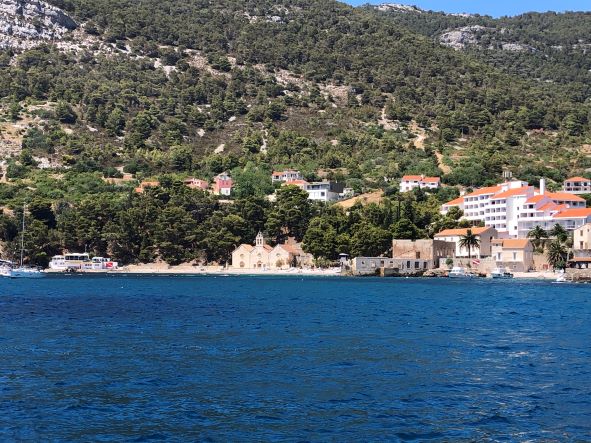
One of the first structures you notice as you sail into Komiža is a beautiful old church sitting right on the beach on the northern side of the bay, the port side of the boat. The Church of the Holy Mary “the Piratess” was built during the Renaissance in the 16th century. It sits on a spring that fed into a well in the church courtyard and provided fresh water for the locals.
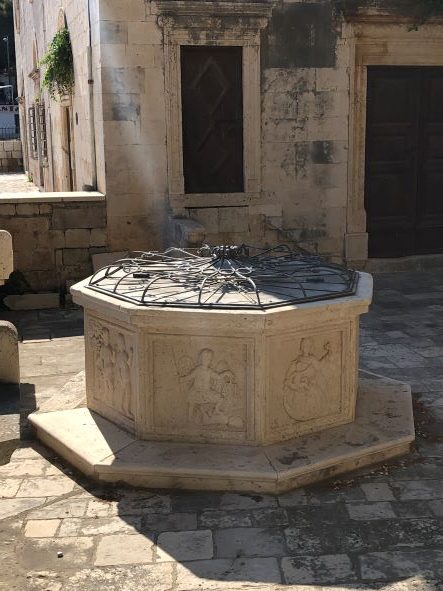
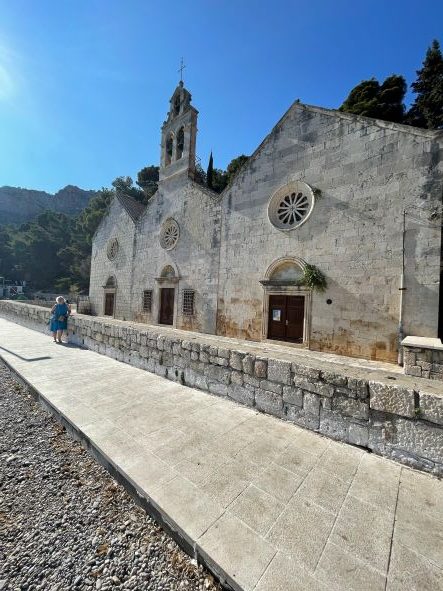
The Saint Mary church was nicknamed the Piratess due to local lore. The story goes that pirates robbed the church and stole a painting of the Madonna. They were unable to sail their ship, and after many attempts returned the painting. Once the painting had been returned, they were able to set sail.
The next structure you will notice sailing into Komiža is the Komuna Fisherman Fortress right near the marina. Komiža faces the open sea, and during the 16th century was constantly threatened by pirate attacks. The village had a thriving fishing industry which was a valued commodity at the time.
To protect the port, the Venetians began construction of the fortress in 1585. Money ran out, however, and the fishermen themselves ended up financing the remaining construction by way of the income tax they paid on their catches!
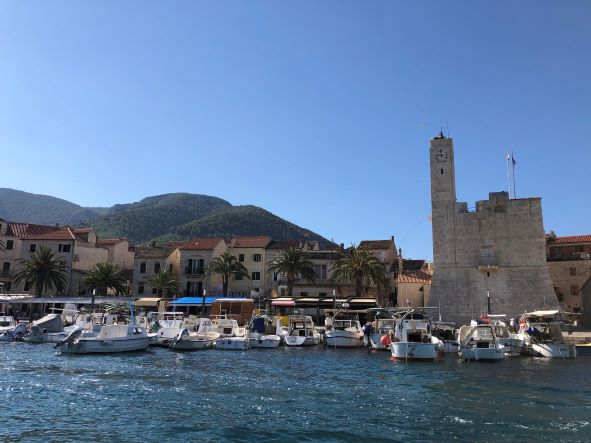
We hiked up the hill to another old church, The Church of Saint Nicholas. This church was constructed by Bendictine Monks and was fortified to protect against, you guessed it, pirates! The church was originally a monastery on the trans-Adriatic Benedictine Route. This route brought Christianity to the eastern Adriatic, and it is documented that Pope Alexander III visited the church on March 10, 1177.
Another interesting bit of history about the Church of Saint Nicholas is the tradition of boat burning. In the historical fishing culture of Komiža, boats were like part of the family. When a boat aged out, it was hauled up the hill and burned on a pyre in front of the church!
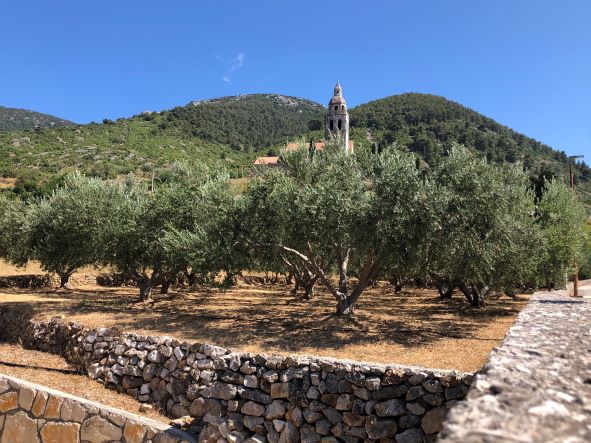
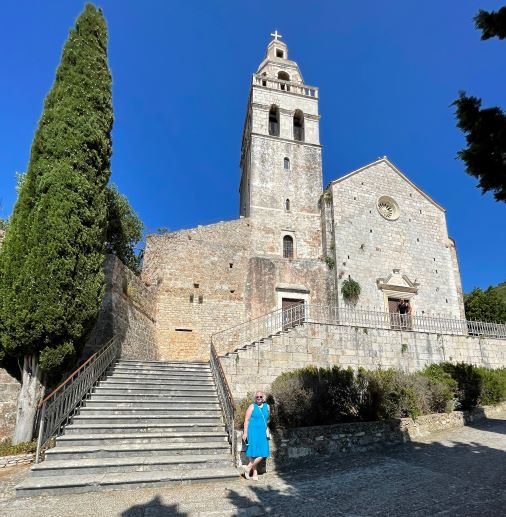
In addition to the historic churches, we also saw some old “walls” that had been constructed while clearing land for vineyards. Walls like these were historically constructed all throughout Dalmatia. Fun facts: the system of walls that runs through Dalmatia is SEVEN times longer than the Great Wall of China!
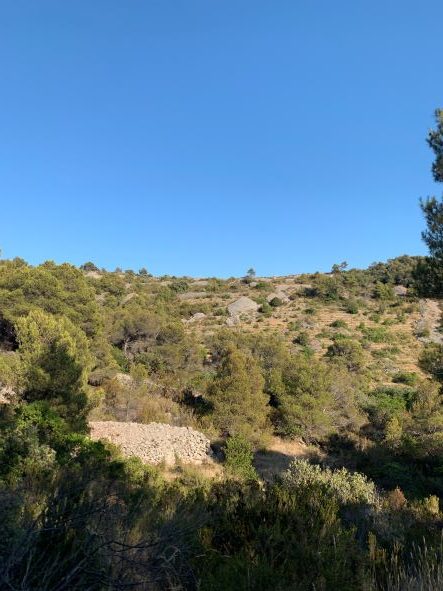
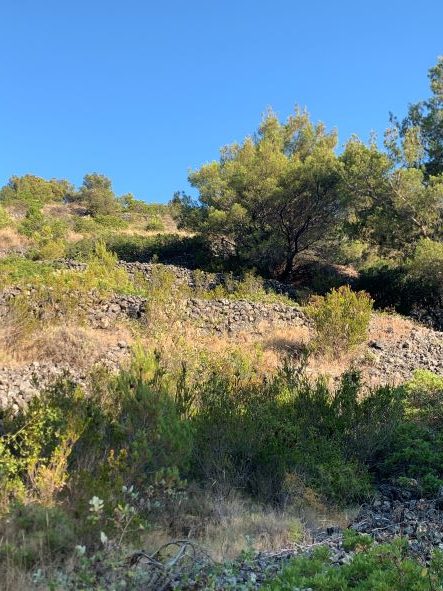
Vis also has a fascinating military history. It served as an Allied base during World War II, and then as an important naval base for Yugoslavia during the Cold War. There are bunkers and tunnels beneath Vis that can be toured as well as a few forts. In fact, Vis only opened to non-locals as recently as 1989! You can catch a military history tour of Vis here.
There are several beaches near the marina in Komiža, and I had time to hop in the water for a swim before dinner. Travel tip – be sure to bring along your water shoes or you might end up with sea urchin spines in your feet like one of our crew! This is true throughout the eastern Adriatic.
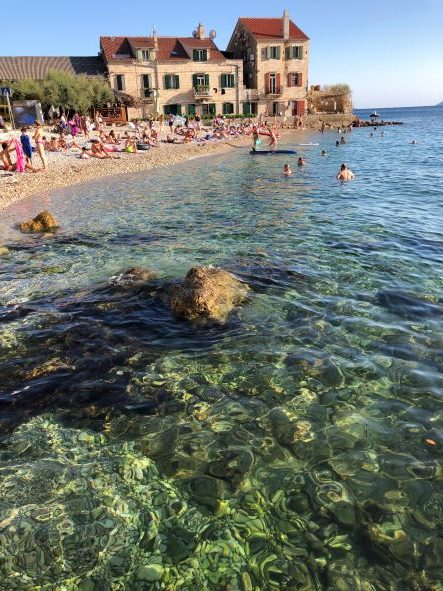
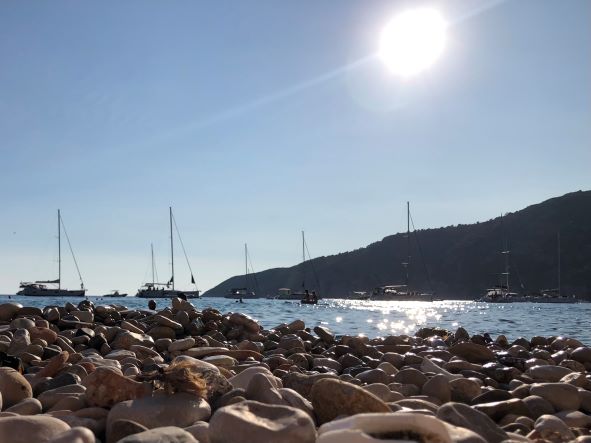
On the way to Saint Nicholas church, we met some locals who owned a restaurant, Pizzeria Charlie, and decided we would have dinner there that night (and also watch the Euro Finals). After the game, we headed back to the boat where we had docked at the marina for the night. This gave us access to the marina showers, which was great, although we saw a lot of people “showering” on the back of their boats as well. Yep, full on butt naked.
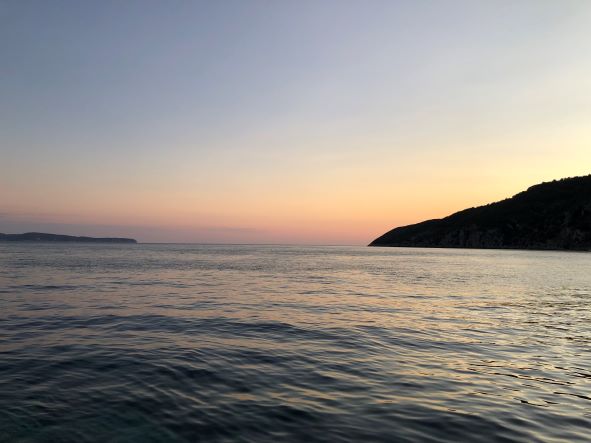
Monday morning, we had just enough time to take a wild ride out to the Island of Biševo to see the Blue Cave or Blue Grotto. (You can purchase tickets at a kiosk near the marina.) Now when I say a wild ride, I mean a wild ride. It was hysterical. I wondered why the boat looked so funny with seats that you straddle, but we soon found out as we bounced over the waves so quickly that you didn’t dare not hang on!
Once we survived and arrived on Biševo, we switched to a smaller boat and headed for the beautiful Modra Špilja, or Blue Cave. The cave is accessed through a tiny mouth that doesn’t really look large enough for the boat to pass through. Actually, you do have to duck! Haha! Once inside, sunlight enters the cave through another opening 4 meters beneath the water level, which makes the water appear to be a beautiful glowing blue color!
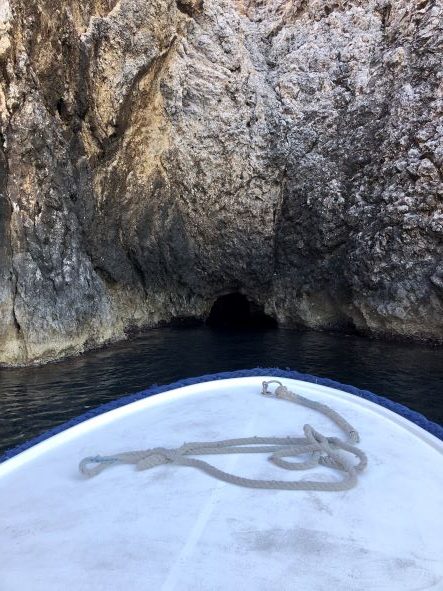
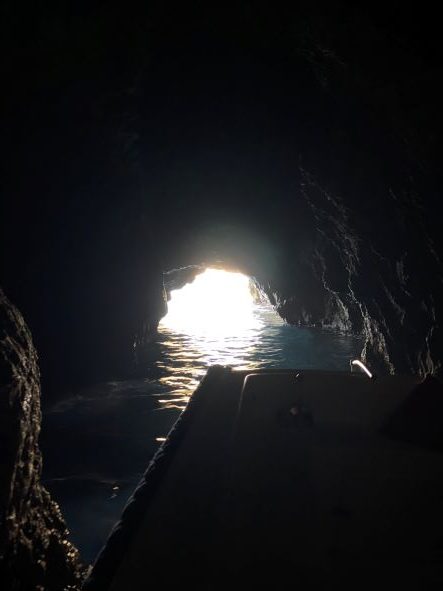
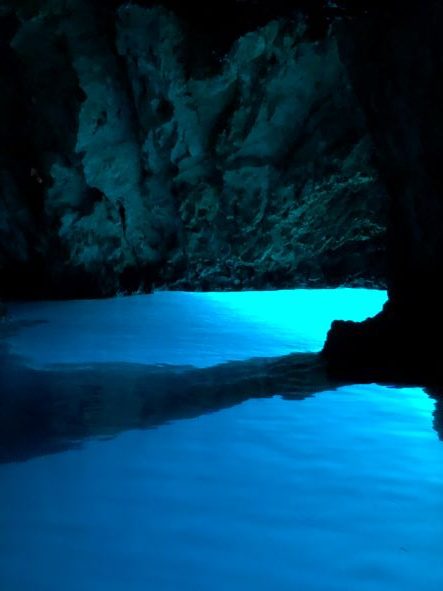
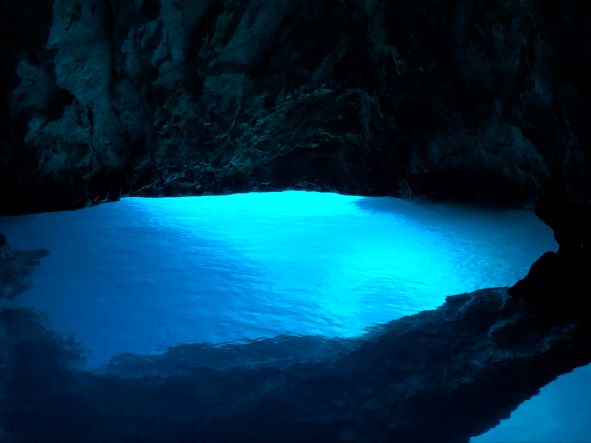
Sveta Nedjelja, Hvar
After bouncing back to the boat from Biševo Monday morning, we set sail for a small little village on the southern coast of Hvar, Sveta Nedilja. On our way, we stopped for lunch and a swim off the coast of Budikovač. The water here was gorgeous ranging from a deep royal blue to a brilliant turquoise!

After leaving our swim stop, we had some fun hanging from the ladder of the boat and being pulled through the water, haha! We also saw our first dolphin today, but I wasn’t fast enough to get a photo!
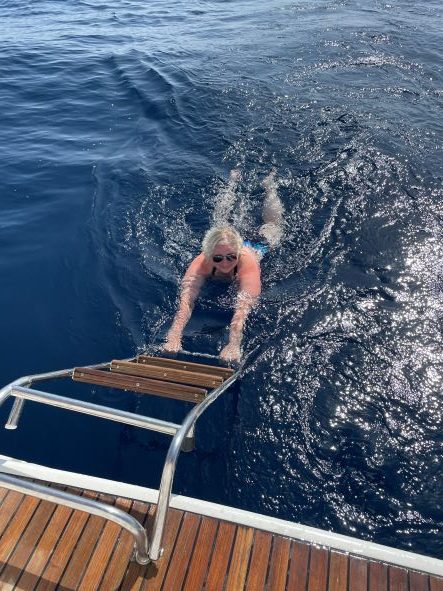
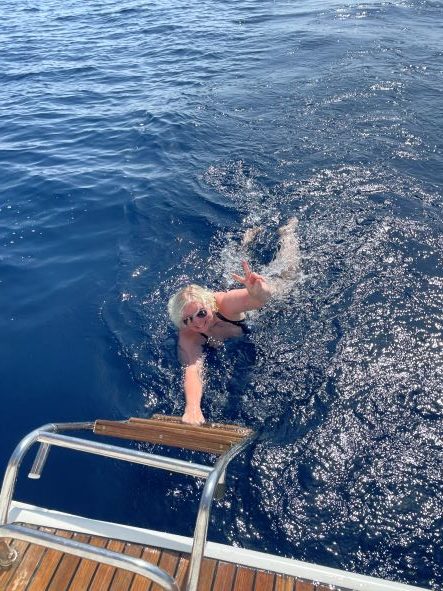
We arrived at Sveta Nedjelja where we had planned to stay at the marina. This marina looked really tricky to get into, but we made it. We had a little time for snorkeling or swimming before dinner at the beach next to the marina.
On the other side of the marina is a family owned restaurant and winery, Restaurant Bilo Idro. We were able to go down into their wine cellar, which was pretty cool. The food here is amazing if you enjoy seafood, as it was all fresh! My shrimp was also served what I call “New Orleans style” with the tails AND the heads still intact. This is one reason why I don’t really like seafood, haha! So much work for so little meat, but what I didn’t destroy was very tasty!
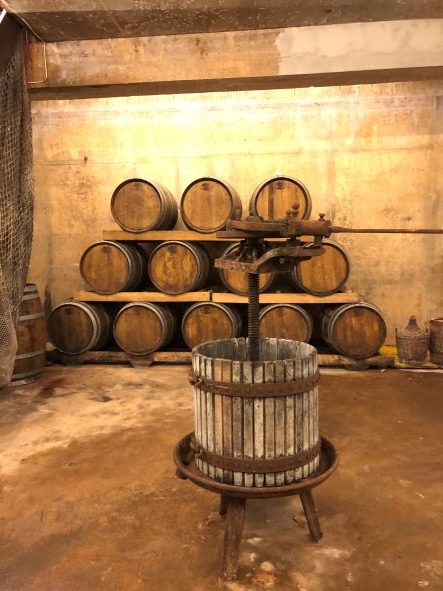
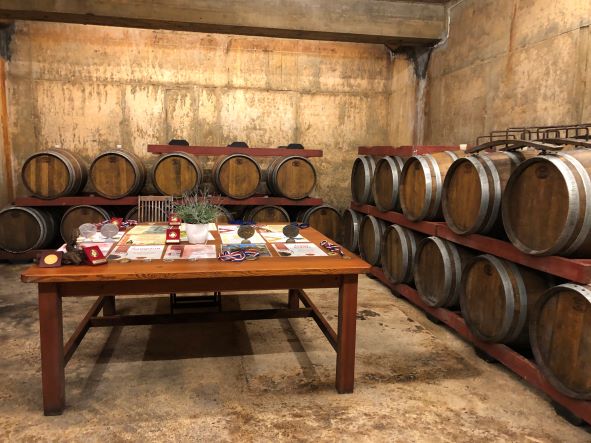
After dinner we headed to the showers, and laughed at the mirror in the women’s bathroom. It was too high on the wall for me to even see my reflection, haha! Then, it was an early night, off to bed for me, in preparation for our early morning hike to Špilja Svete Nedjelje! I had been looking forward to this hike for months!
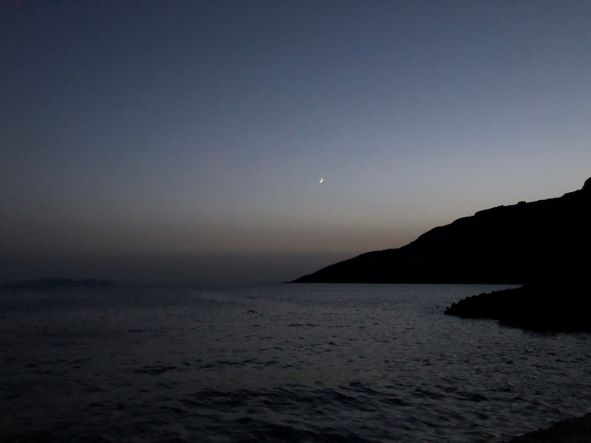
Tuesday morning we woke up at a decent time to head up the highest peak on the island. The hike was only 1.2 miles (2.4 round trip), but the elevation gain was 1,204 feet. This hike was STEEP! It was no joke, and it kicked my butt! Coming down was worse than going up, my knees were really angry! Having said that, it was TOTALLY worth it!!

Špilja Svete Nedjelje is a cave that was inhabited as far back as the Neolithic Age! But what makes it even cooler, is what remains of the 15th century Augustinian monastery and church! The remains of a cemetery, and a spring fed well can also be found in the cave along with a Madonna shrine, and a bell that you can still ring!
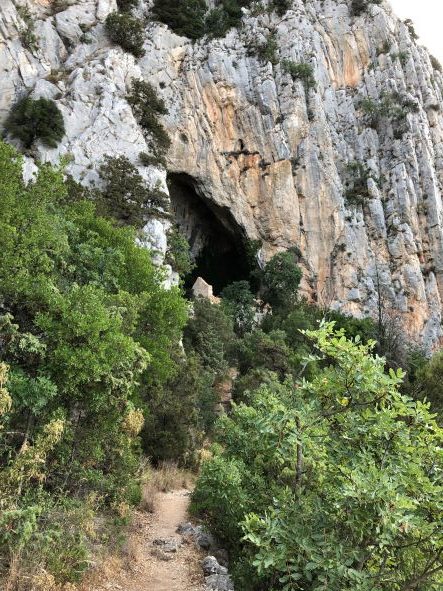
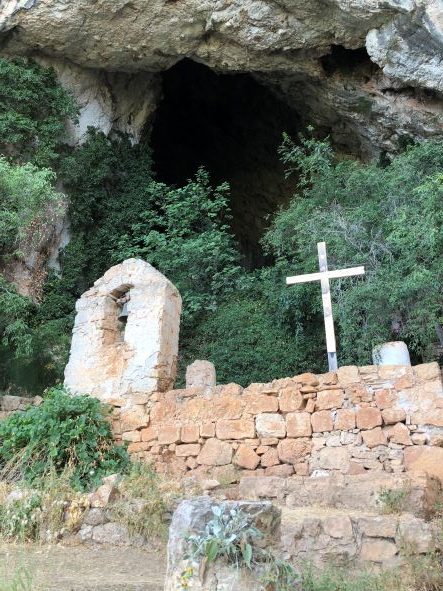
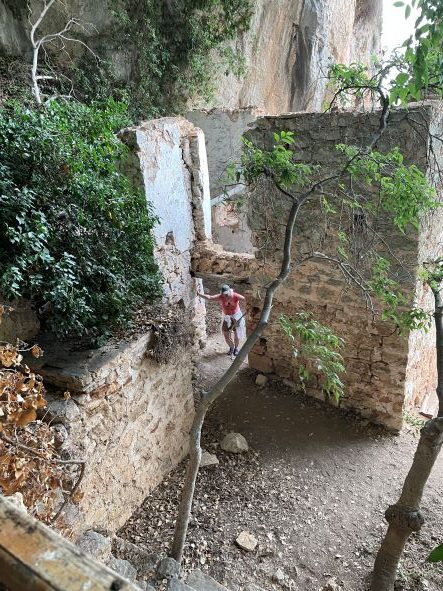
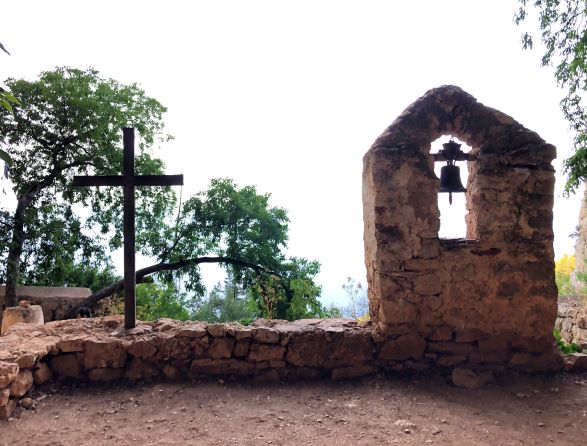
I loved the bell in particular. I have not written about this much, but in October of 2019, I was diagnosed with breast cancer. I went through some chemo and two surgeries, and I am blessed to be cancer free and reconstructed! One of the things you do when you finish cancer treatment is ring a bell, so of course, I rang this old bell as well!
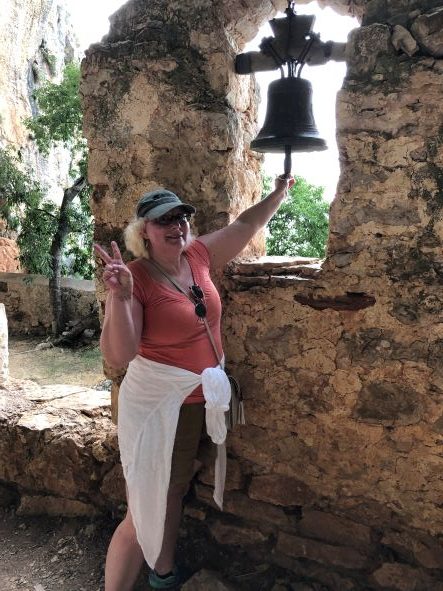
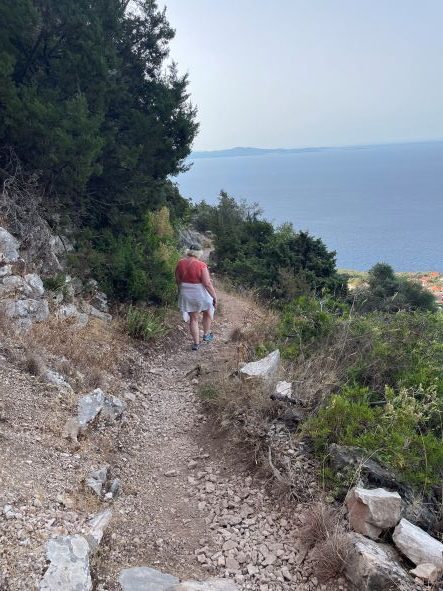
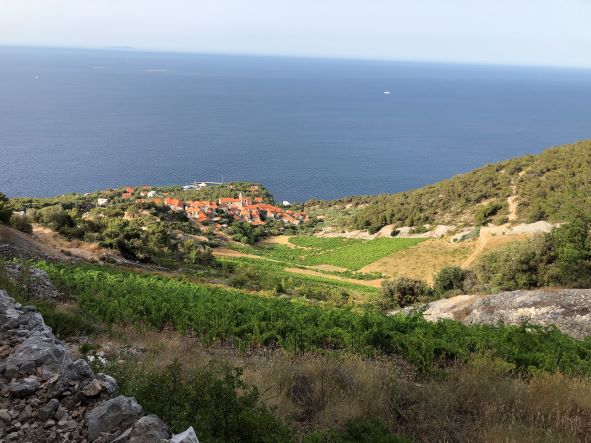
We took some photos from the cave, the view was stunning, and began the trek back down the slope. The view on the way down is breathtaking between the vineyards on the hillside and the sea. We were almost halfway down when we got a call from a crewmate telling us we had to hurry back because our skipper wanted to leave immediately due to the weather!
We still had at least 20 minutes left to go, but we kicked it into high gear. I think this is the real reason my knees hated me that day! Remember the slope was steep! I won’t lie, I was pretty frustrated with that call, because we could only do what we could do.
Once we reached the marina, however, I understood the urgency. The waves were picking up and really rocking the boat. We had to get out of the marina fast! Remember, this was the tricky one anyway without high winds and waves, but we made it out safe and sound.
Loviste, Peljesac Peninsula
Our first stop of the day was a village called Loviste on the Peljesac Peninsula (actually part of the mainland). They are very well known for their wine. We had dropped anchor in the bay, so we swam to shore for a quick sip! We didn’t stay long because the goal was to get to Korčula City for the night, and the winds were still strong.
As we headed out to sea toward Korčula City, a gale warning came across the radio. What??!!?? We were in Force 7 winds. Now, I honestly had no idea what this meant, but it sounded bad, so I asked. Our Skipper reassured us that he would make sure we were safe. He explained that it meant strong wind, and that we now had bragging rights that we sailed through Force 7 winds our first time sailing. Haha!
Later, after we got home, I looked up this Force 7 wind thing. It comes from the Beaufort Wind Scale which was developed by Sir Francis Beaufort of the British Royal Navy in 1805. It is a scale used to measure wind based upon observations. Force 7 is “near gale” with winds from 28-33 knots. Gale force is considered Force 7-9 on this scale (Force 8 is gale, and Force 9 is strong gale).
I was thankful for my Dramamine that day! We actually ended up turning around and sailing back to Loviste to spend the night. The harbor there was sheltered from the wind. It was also very crowded, not surprisingly. We did find a buoy and dropped anchor for the night. Safe and sound as Skipper Paul promised.
Korčula Town & Vela Luka, Korčula
Wednesday morning we got an early start and set sail once again for Korčula Town, Korčula. Sailing into Korčula is quite the sight! The Old Town sits on a peninsula, and is surrounded by old walls and watch towers. It is quite impressive! There is also some history/local lore here to explore, and Korčula has been inhabited since prehistoric times!
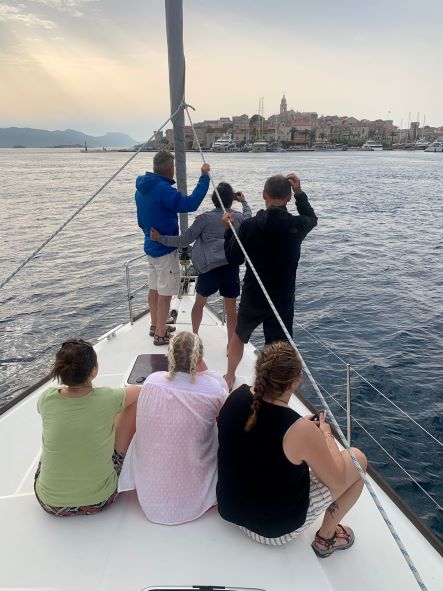
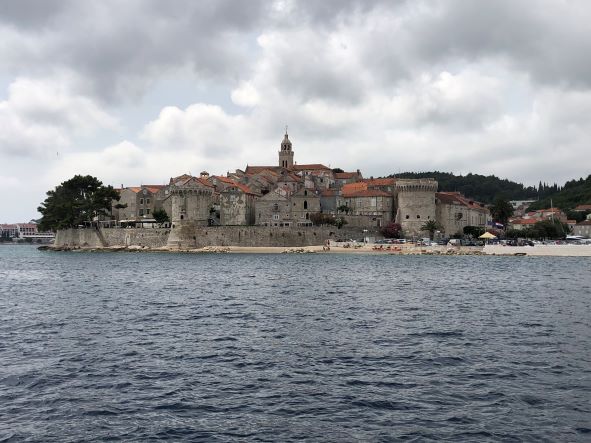
First, the construction of Korčula Town’s Old Town itself was fascinating. The side streets branch off of the main street, which runs north to south along the top of the hill, almost like fishbones. The east side streets are curved, and the west side streets are straight. The design was intentional to help block “bora winds” which are cold north-easterly winds that blow across the Adriatic, while allowing the summer winds through. I thought this was very ingenuitive for the time. The walls of the city were built in the 13th century, the Land Gate leading into Old Town was built during the 14th century, and the watchtowers were added later by the Venetians in the 15th century.
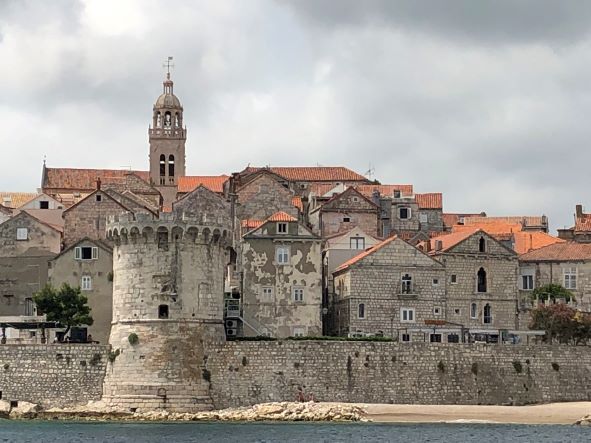
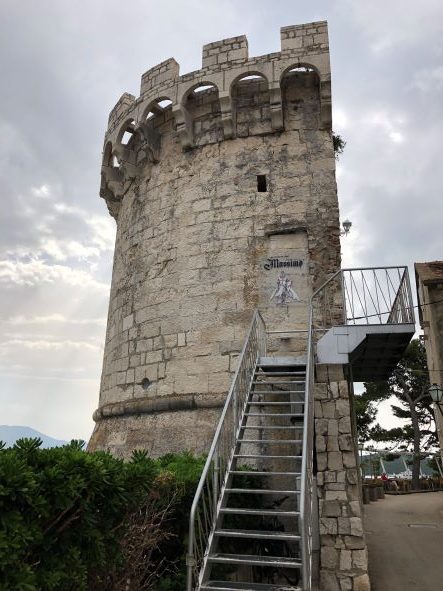
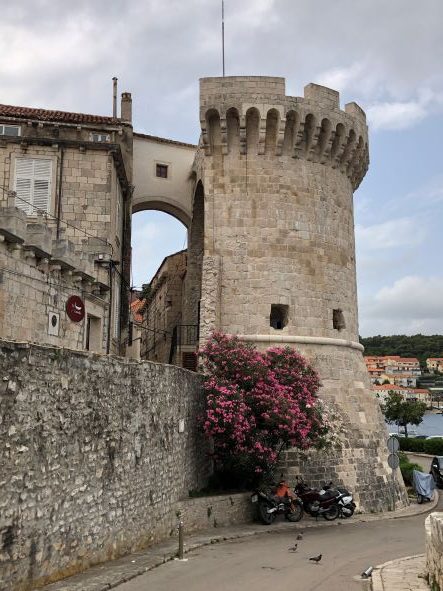
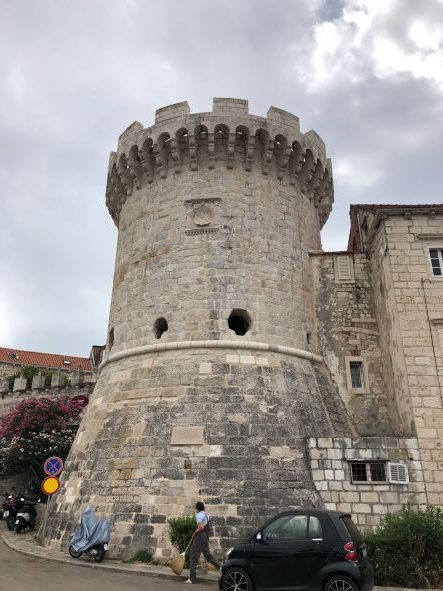
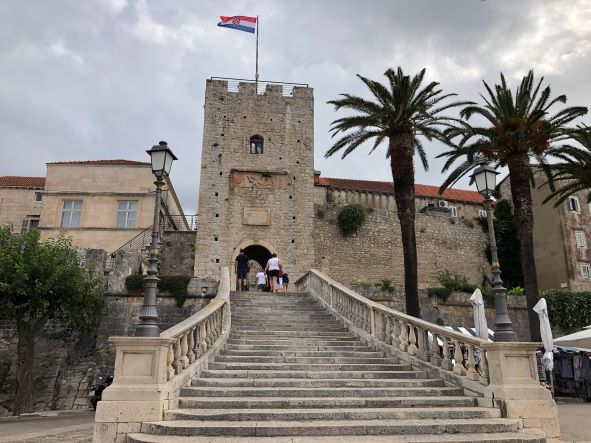
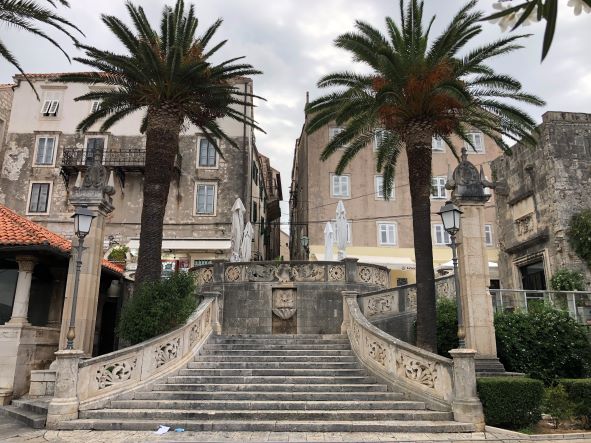
Speaking of Venetians, another fascinating find in Korčula Town, is Marco Polo’s alleged birthplace (as opposed to Venice)! This is plausible, I suppose, as Korčula was under the control of the Venetians at the time of Marco Polo’s birth in 1254. He would still be Venetian even if he were born in Korčula Town. The home is located in Old Town near Saint Mark’s Cathedral. You can’t miss it, there is a rather large sign. Korčula Town was just a beautiful place to wander.
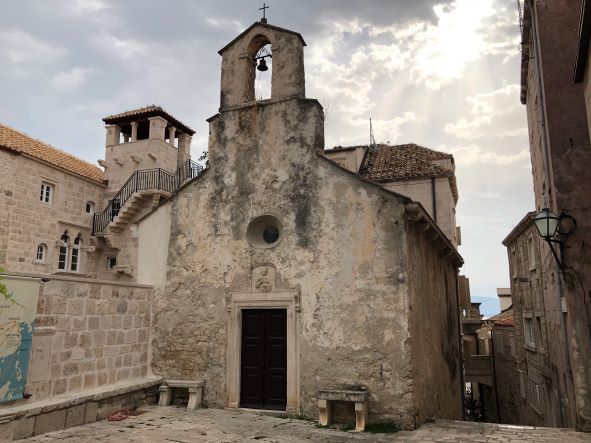
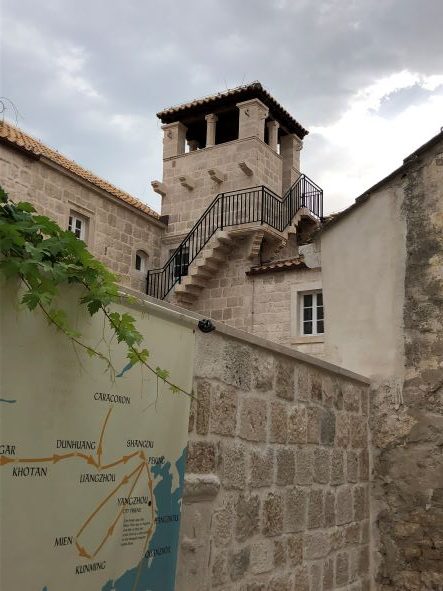
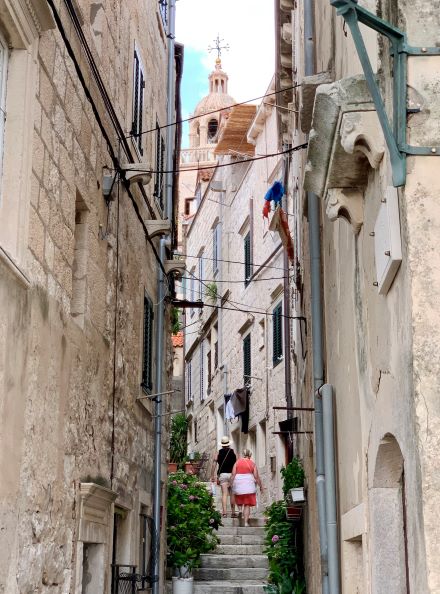
From Korčula Town, we sailed to the other end of Korčula Island to the town of Vela Luka. This town was pretty, but our Force 7 wind adventure the previous day caused our time here to be cut short. We really just had time for an amazing dinner at Konoba Bata when we arrived. Next time, I am hoping for time to explore Vela Spila, a cave and archaeological site that dates back to the Stone Age. We overnighted in the marina in Vela Luka
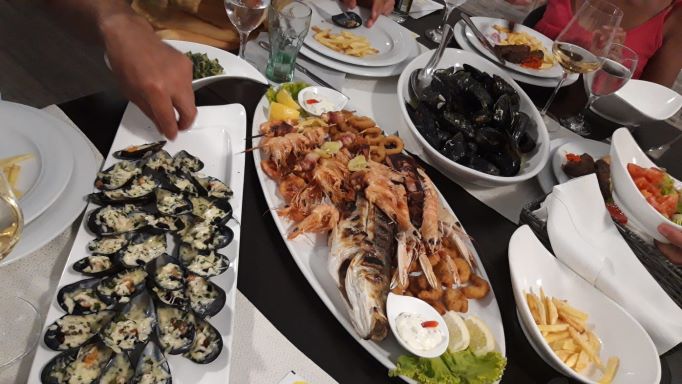
Marin Kovač, Pakleni Islands & Stari Grad, Hvar
Thursday morning we set sail for Stari Grad on Hvar. It was a fun day on the boat. The wind caused the boat to heel (lean) pretty far over, to the point that a few of our “crew” were a little nervous. Haha! One of our “crew” took a great picture below deck of the stove looking crazy when the boat was heeling – thanks Jerome!
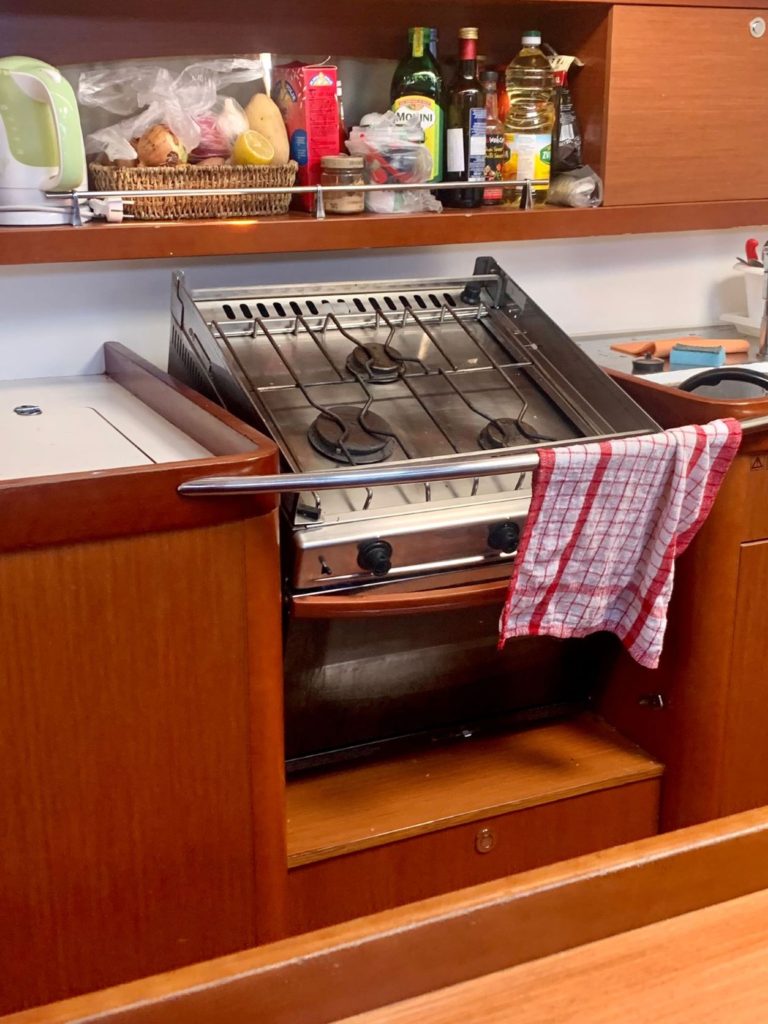
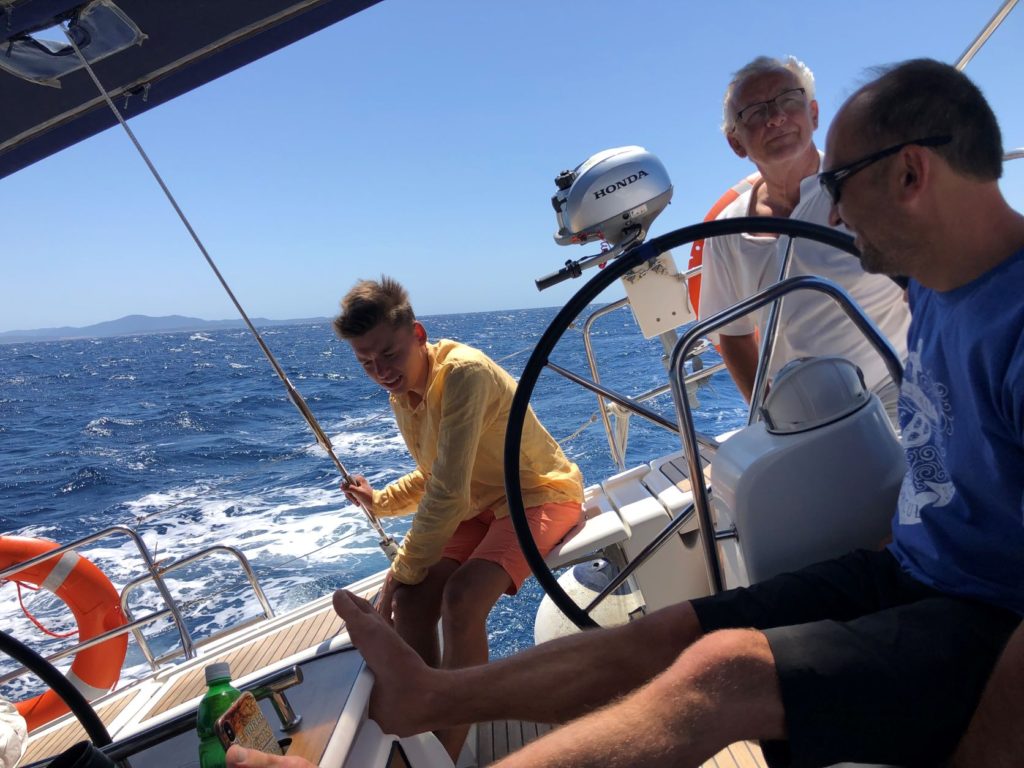
We stopped for lunch and a swim at a place called Carpe Diem Beach on Marin Kovač in the Pakleni Islands. We took the dinghy in as it was a pretty good distance to swim from where we dropped anchor. This place was by far the most “Instagrammable” stop on our whole trip. There were so many places for photo opps it was almost comical. No, it was comical, but also fun. We “seized the day” and took advantage of a few of these places, and then took the dinghy back to the yacht.
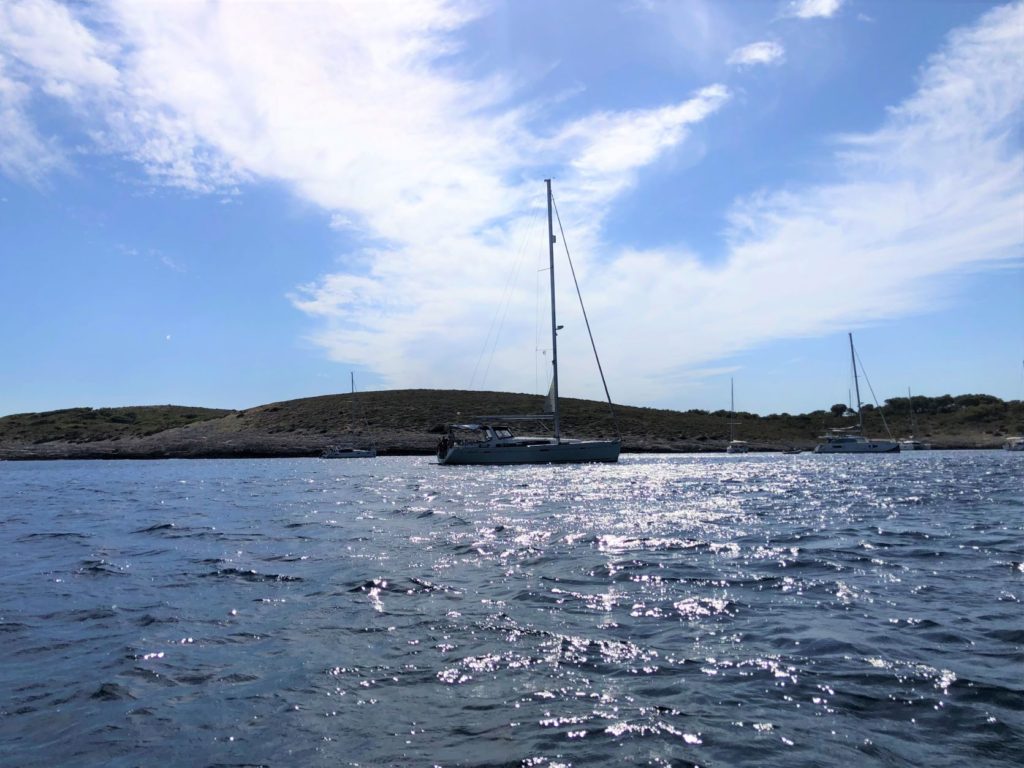
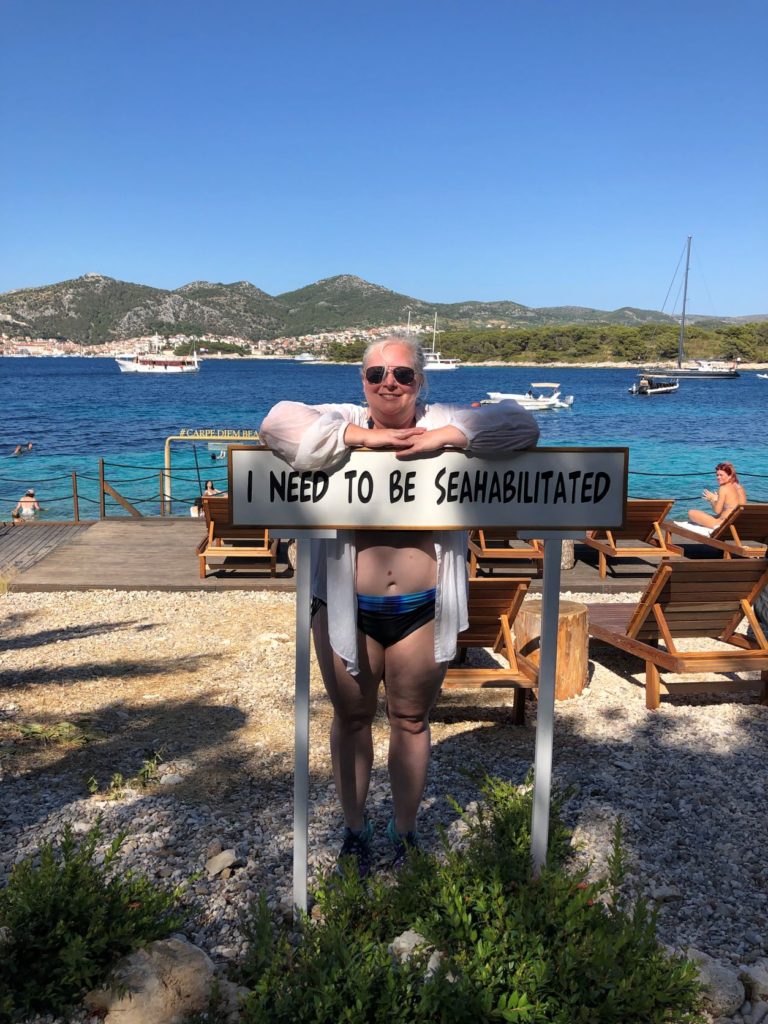
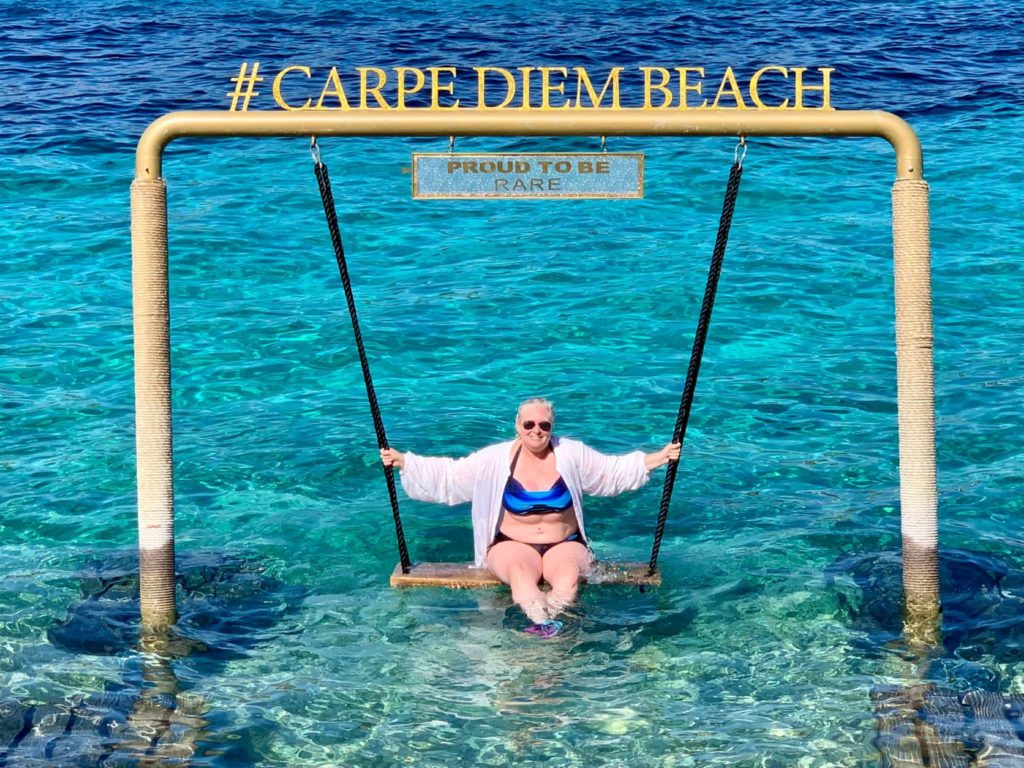
From Carpe Diem Beach, we sailed on to Stari Grad on the northern side of Hvar. We again elected to dock at the marina. We actually had time to wander around Old Town, (which is what Stari Grad actually translates to in English) before dinner.
We thoroughly enjoyed walking the winding streets. Our first destination was the Dominican Monastery. On our way, we passed by the Saint Rocco Church. Saint Rocco is the patron saint of Stari Grad. The remains of a Roman bath were also discovered beneath the floor of the church. Unfortunately we were not able to go inside at the time of our visit.
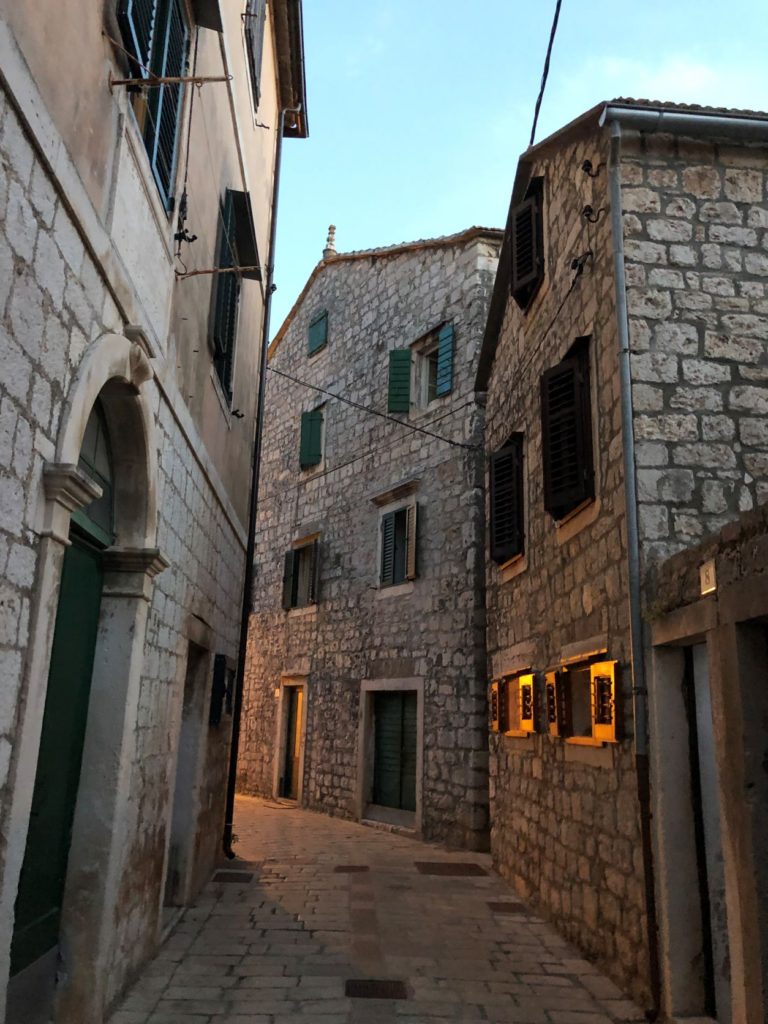
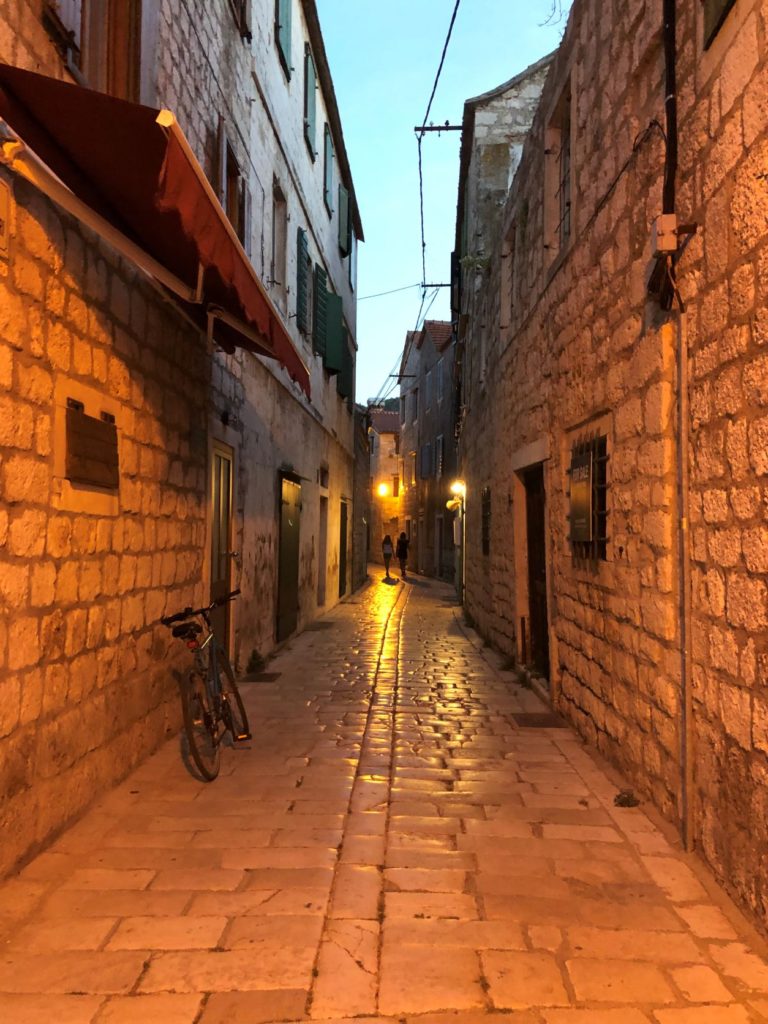
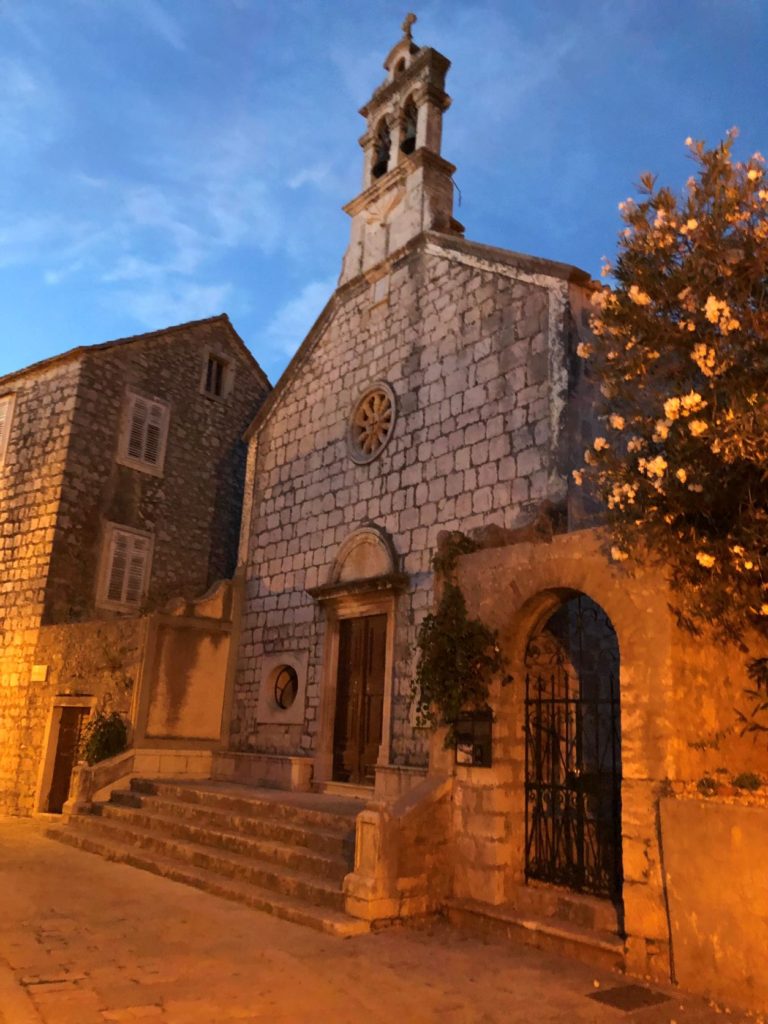
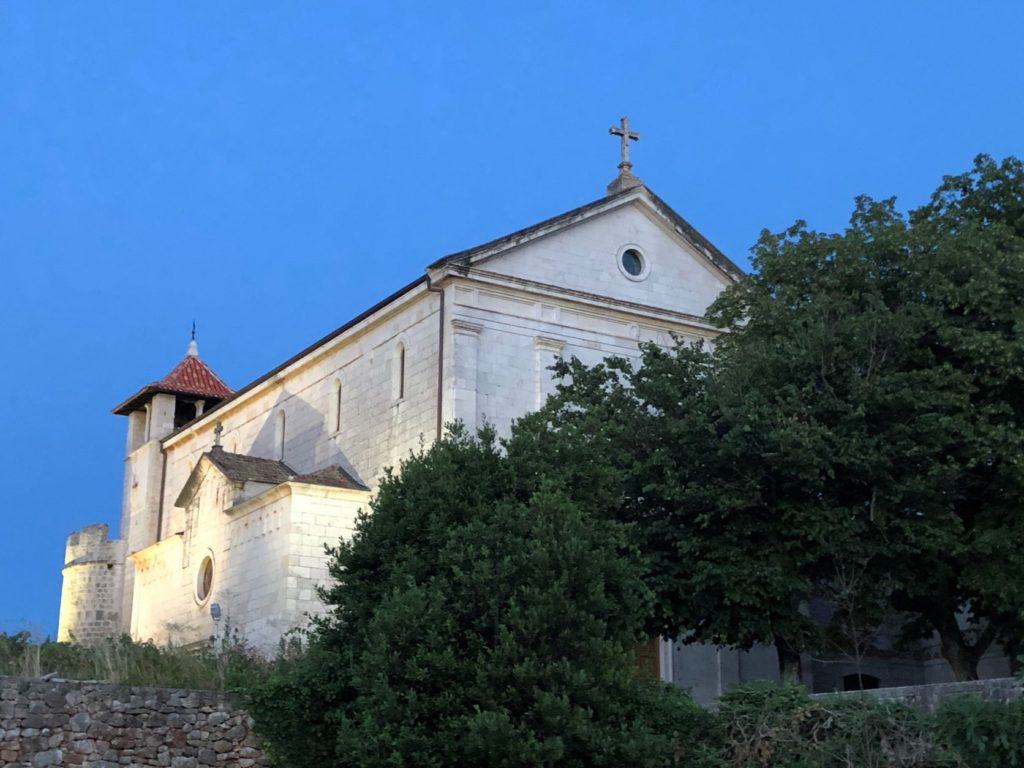
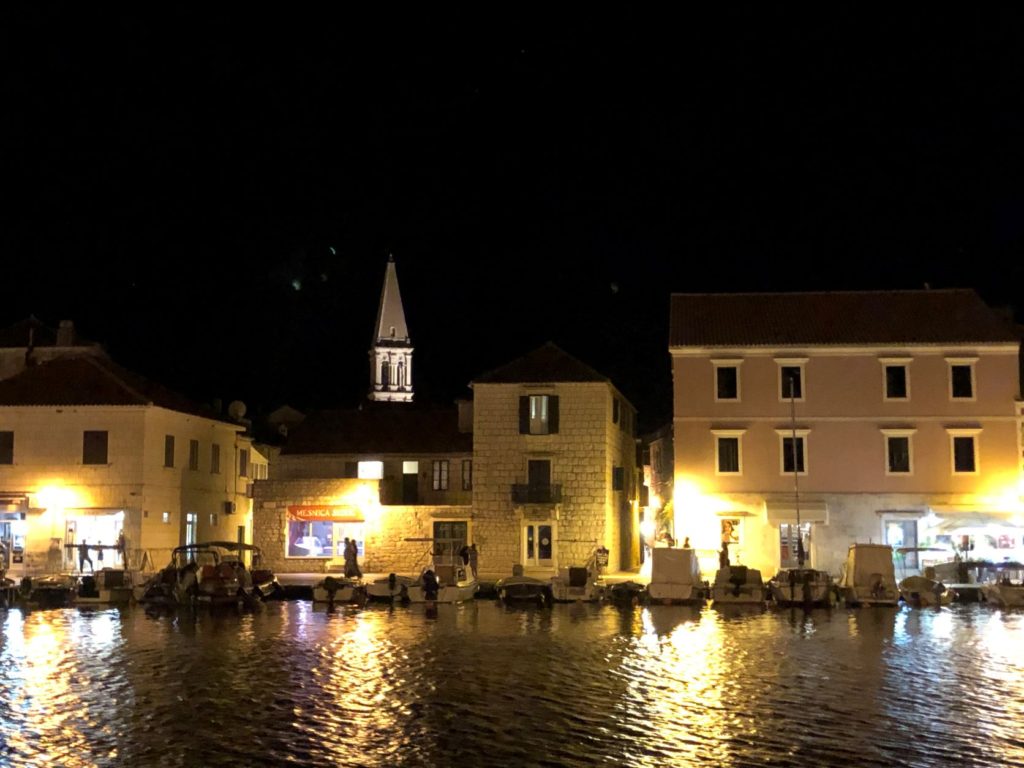
On the edge of town, is the Dominican Monastery. It was founded in 1482. We got there just in time to hear the bells ringing. We wandered back to the waterfront where we met our “crew” for an amazing Italian dinner at a restaurant called Va Bene. We followed dinner up with gelato and called it a night.
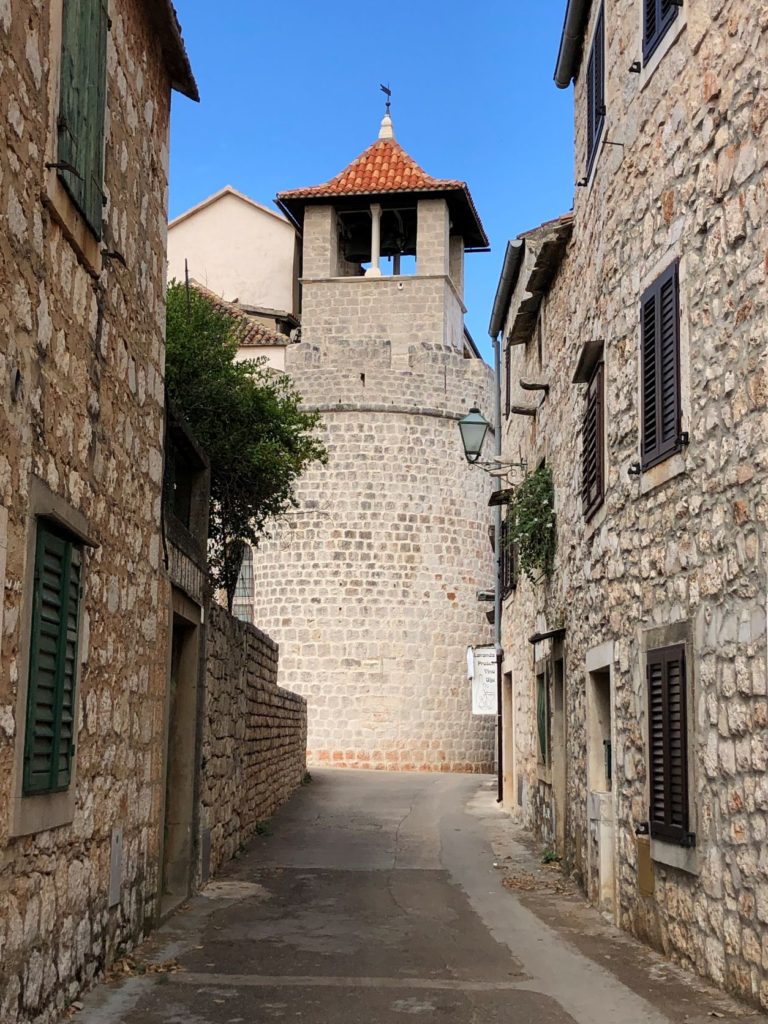
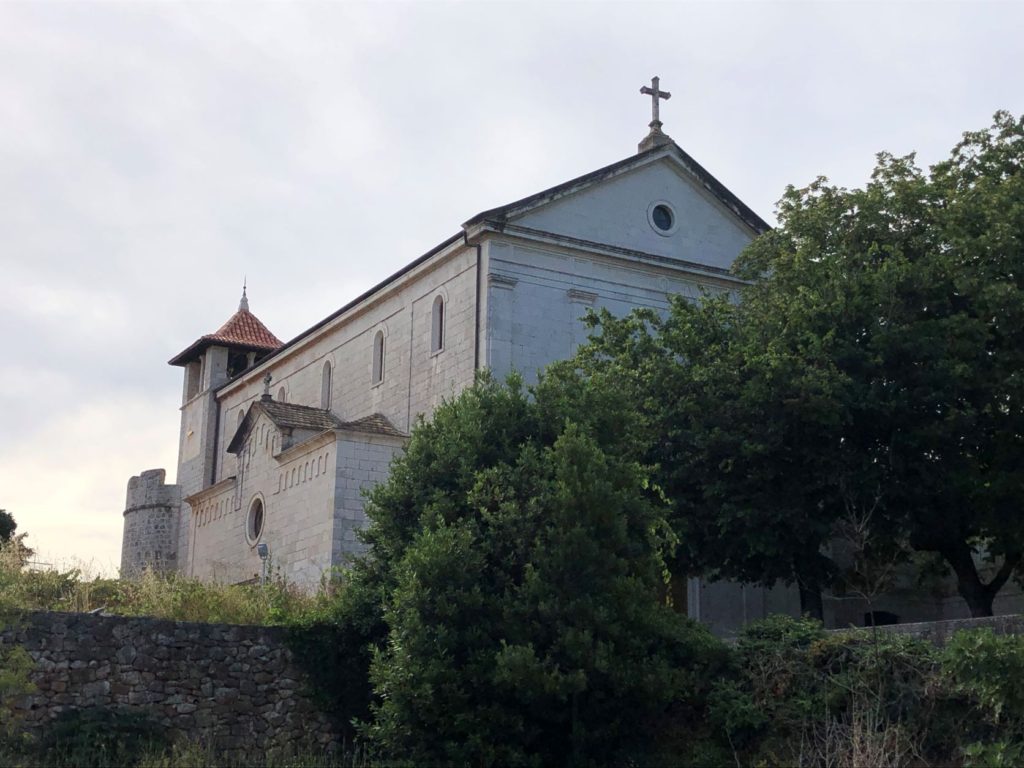
Friday morning, we had a little more time to explore, so I headed back to the Monastery for some daytime photos. I also learned a little Stari Grad history. Stari Grad was originally Pharos, founded by the Greek Syracusans in the 4th century. It was later taken by the Romans, Byzantines, medieval Croatian kings, and the Venetians.
I passed a few other old churches on my way back from the Monastery. I was quite obsessed with these. The first was the Church of Saint John. What is left of the original walls of this church date all the way back to the 5th century. The vault was added in the 11th century, and the rosette in the 14th century.
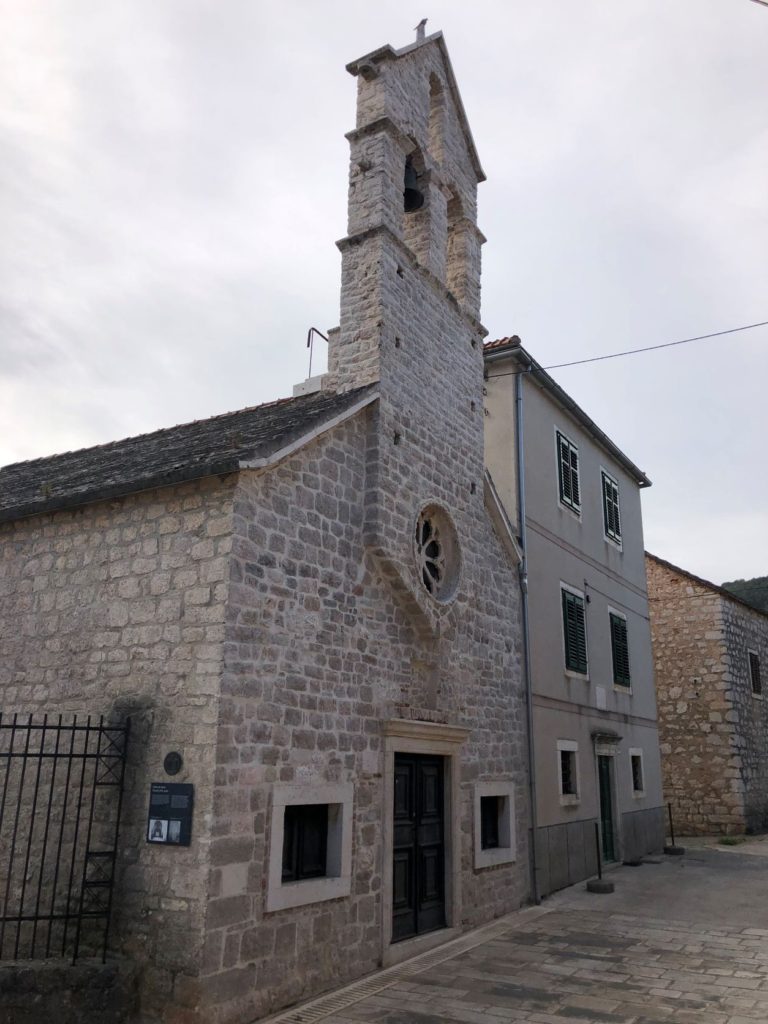
Next, I wandered into Saint Stephen’s Square which includes a bell tower built in 1753 containing some of the same stones from the walls of Pharos. An old 17th century church also called Saint Stephen’s occupies the square, and near the side of the church you can see a 2nd century Roman relief of winged Eros just out there in the elements.
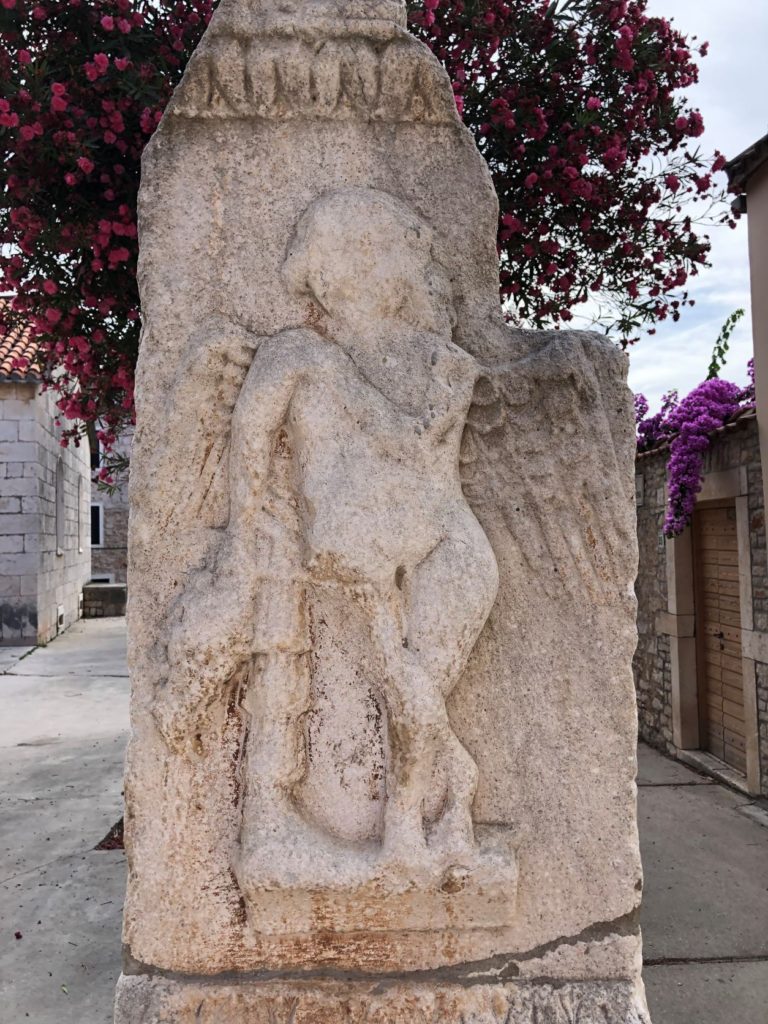
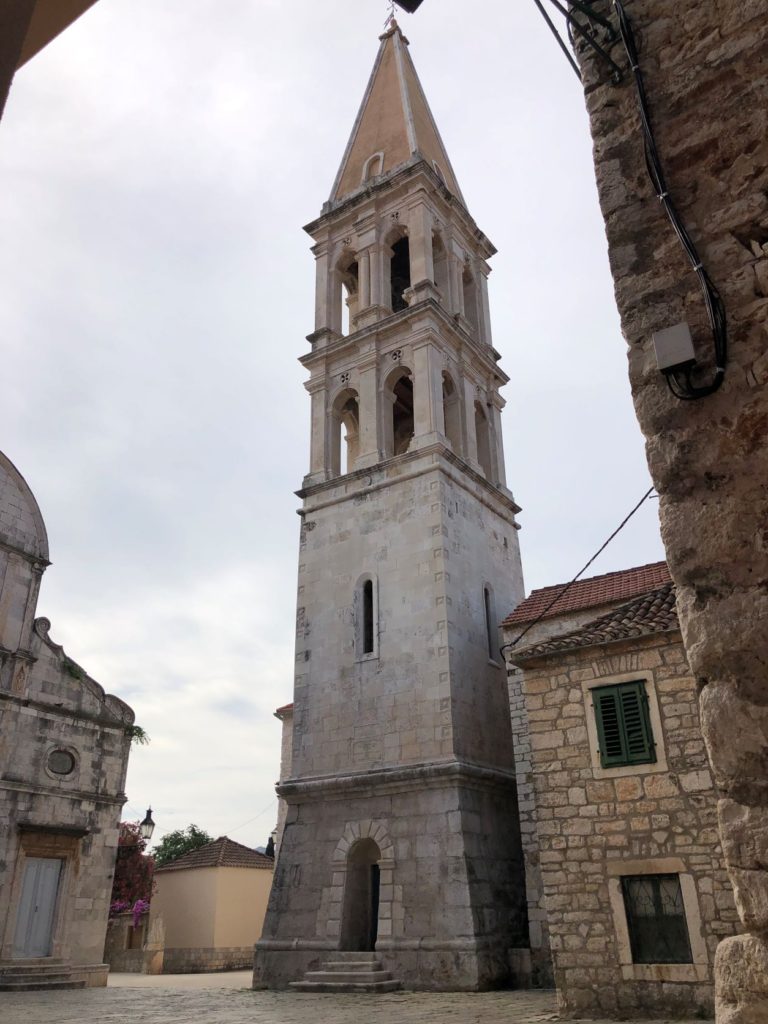
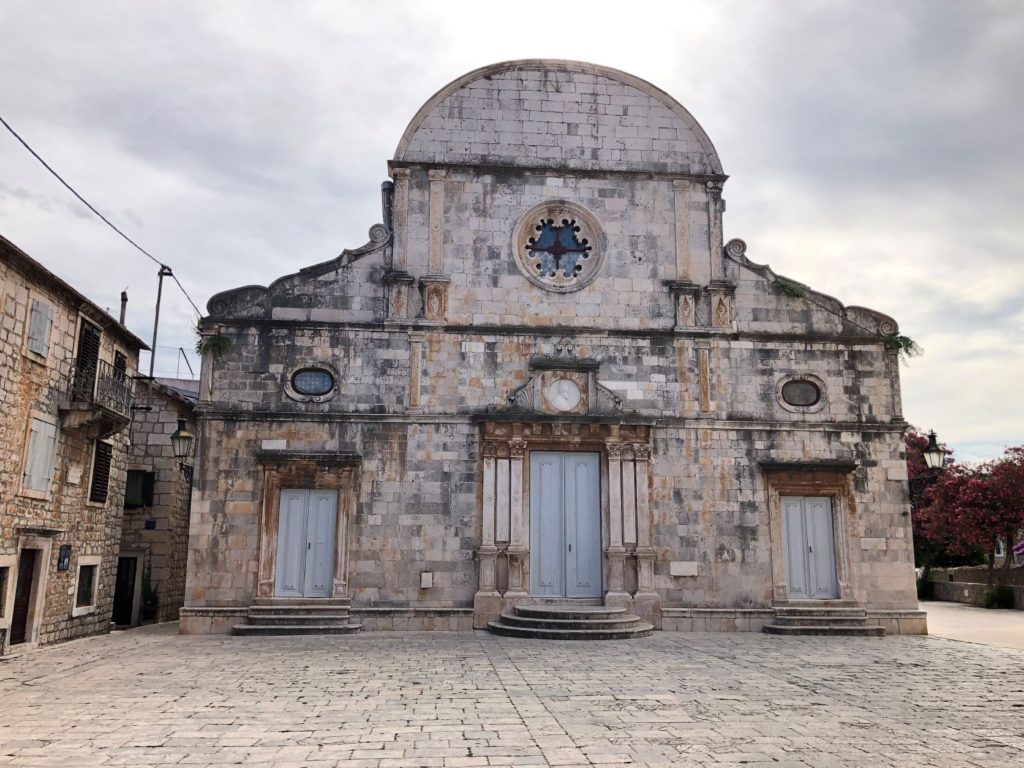
This location of Saint Stephen’s Church was the site of the island’s first cathedral in the 12th century. It was abandoned in the 13th century and demolished when the cathedral was moved to Hvar Town. Construction began in 1605 on the church that is standing today!
Milna, Brač & Trogir
Once we set sail from Stari Grad, we headed back to Trogir. It was our last day on the yacht. We saw more dolphins and had a great time sailing. We stopped for a very short lunch stop at Milna on the island Brač. We walked around Milna taking in the architecture and the history. This town had a pretty beach with more of the crystal clear water. I did stop for a quick swim on the way back to the boat.
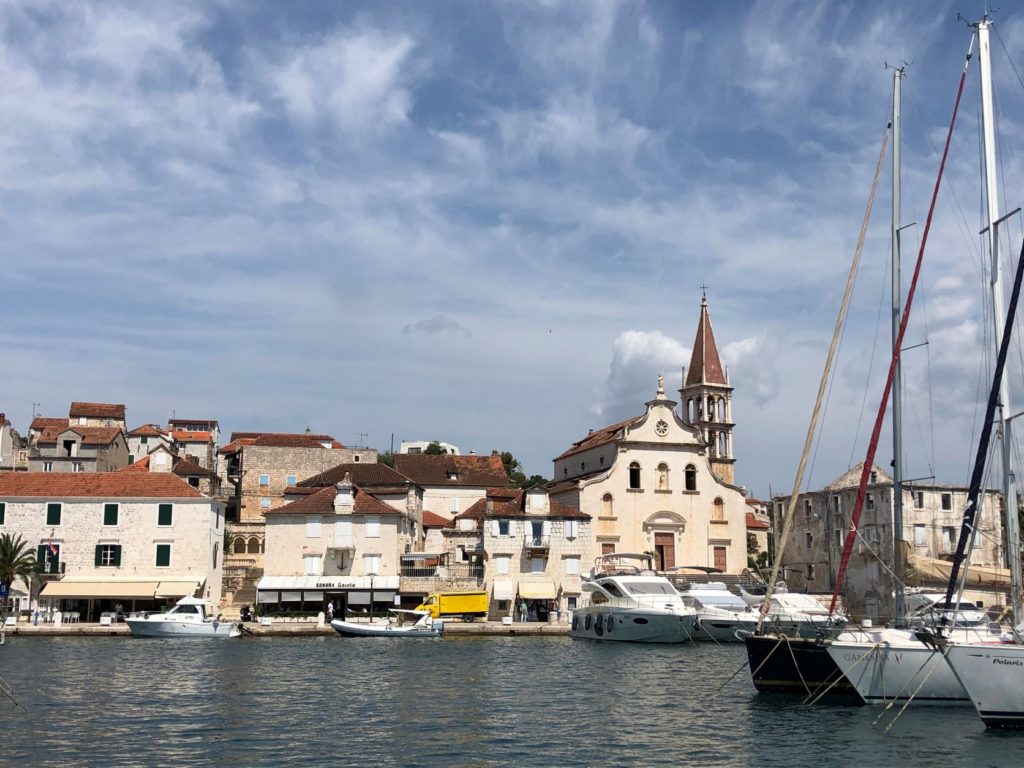
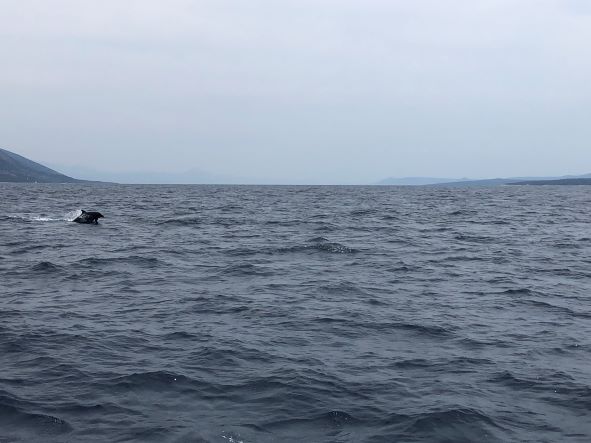
We sailed back into Trogir late in the afternoon, and had enough time to sail past Old Town before sailing back to the marina. From the Marina, we walked back into Old Town Trogir to wander around and eat dinner. We had a fabulous dinner at a restaurant called Riva. It was delicious. After dinner we headed back to the boat for our last night aboard.
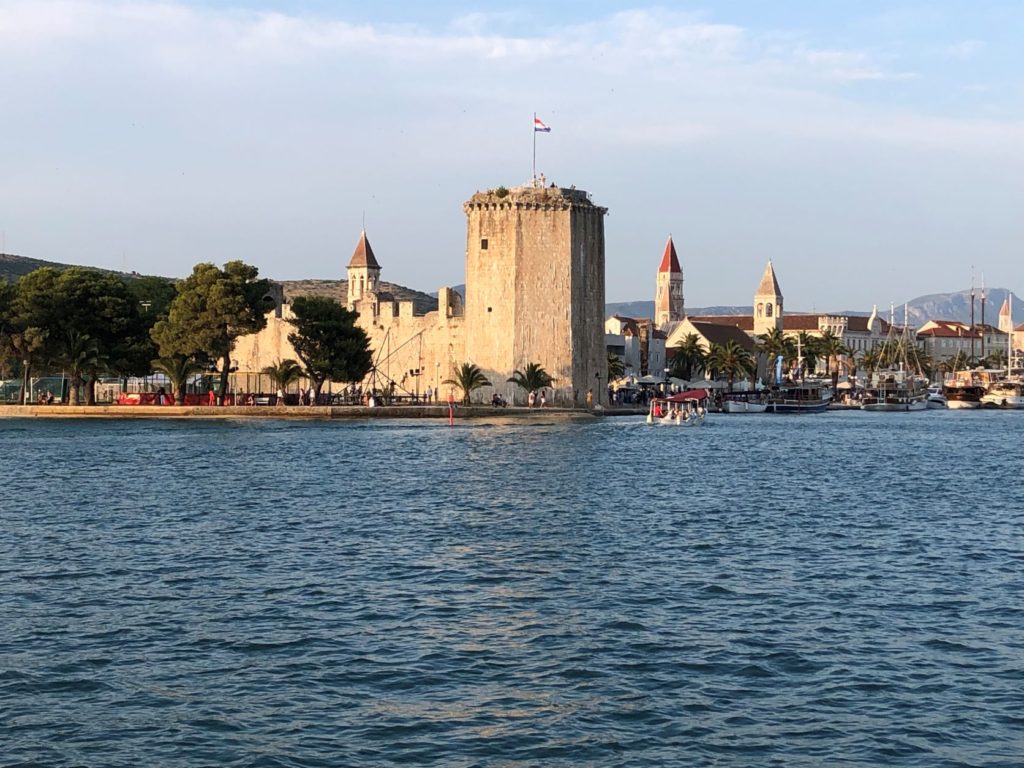
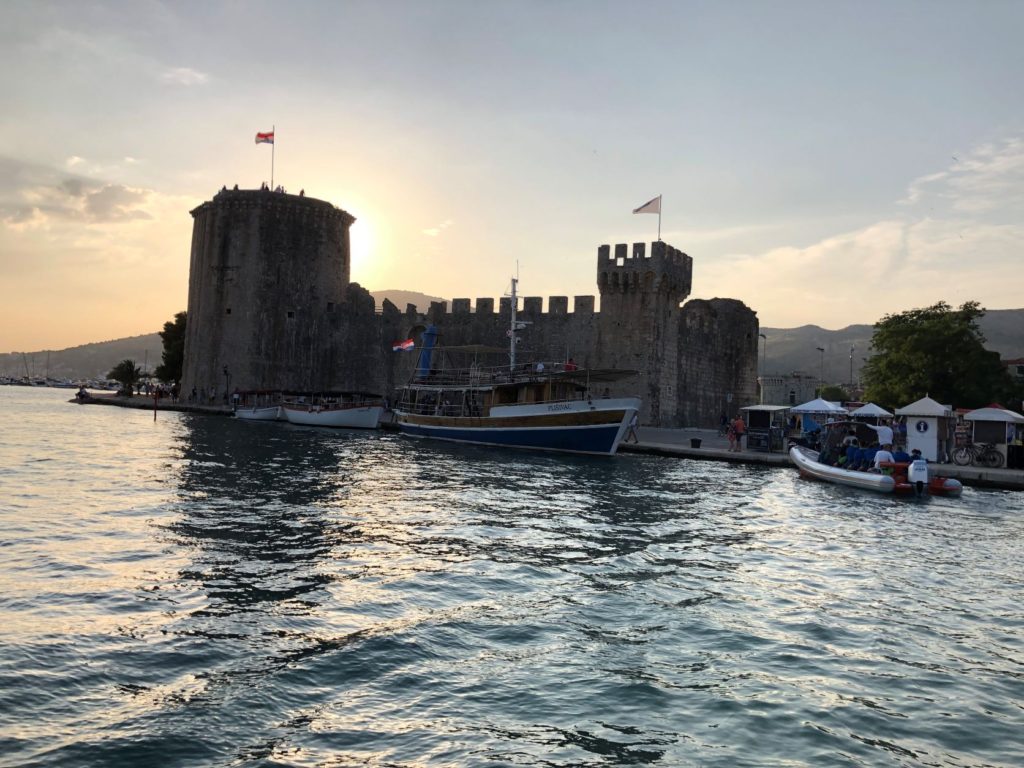
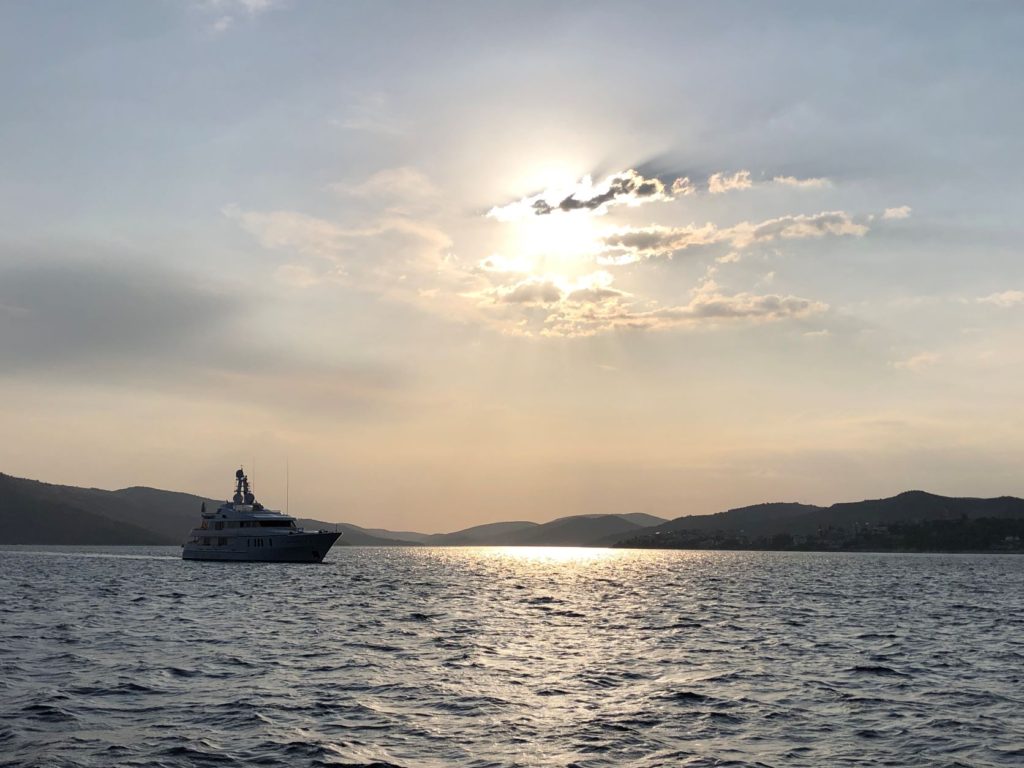
Saturday morning when we woke up, we stripped our bedding and disembarked. We took a cab to the Split Airport, where we stopped by the Covid testing site that was right outside. This was by far the most stressful 15 minutes of the trip – waiting to get our results. All was well, however, we both tested negative. Our last stop before flying out was the town of Split.
We rented a car, and my daughter drove. It wasn’t too bad. The problem was finding parking once we got to Split. We ended up parking on the side of the road in a dirt area that I can only compare to parking in the grass next to an entrance ramp to one of our interstates in the US. We then walked the mile into Old Town.
All of this because I couldn’t come to Croatia, and be so close to Split, and not go to see the Old Town and Diocletian’s Palace! Diocletian became the emperor of the Roman Empire in 284, and when he retired in 305, he moved to this palace to live out his remaining years. (If ancient Rome is your thing, check out my post on Naples & Rome!) By the time we found parking and walked into Old Town, we really didn’t have much time to do anything other than walk through the narrow streets – very quickly I might add! Haha! This will be on my list again next time!
If you are interested in this trip, I am heading back again this summer from July 9-16, although there are several other weeks available as well. You can check it out at Traveling Teachers. If you decide to book for this summer, I would love for you to use my affiliate link! And if you are interested in booking in the future, you can contact our skipper, Paul at paulvfinnigan@gmail.com or on WhatsApp at +48 513 967 635!


